Customer Retention in Telecommunication Sector in New Zealand
VerifiedAdded on 2023/04/05
|26
|4748
|204
AI Summary
This research proposal aims to study the customer retention in the telecommunication sector in New Zealand, focusing on companies like Vodafone, Spark, Skinny, and 2degrees. The research will explore the impact of service quality, influence of service on customer satisfaction, switching costs, and customer loyalty in the industry.
Contribute Materials
Your contribution can guide someone’s learning journey. Share your
documents today.
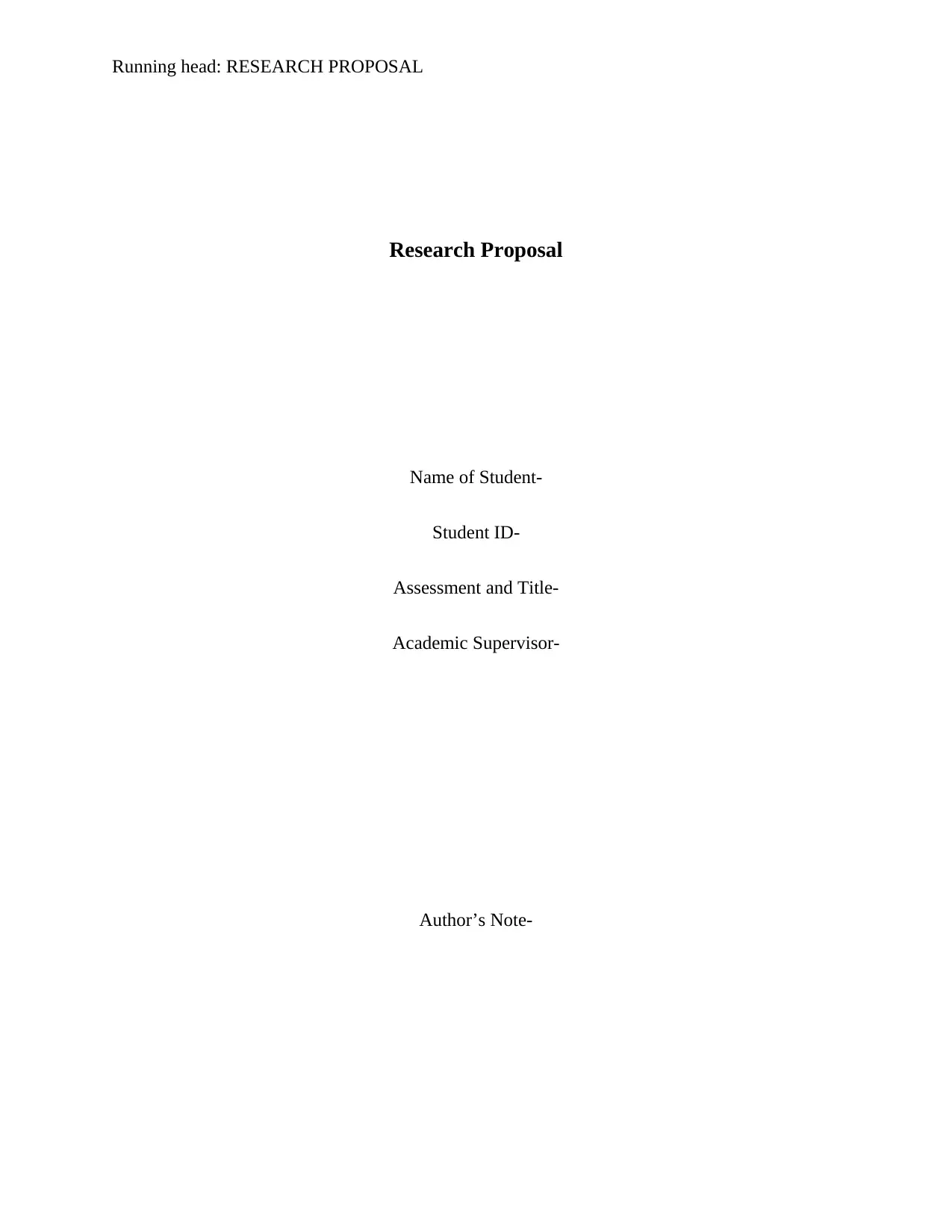
Running head: RESEARCH PROPOSAL
Research Proposal
Name of Student-
Student ID-
Assessment and Title-
Academic Supervisor-
Author’s Note-
Research Proposal
Name of Student-
Student ID-
Assessment and Title-
Academic Supervisor-
Author’s Note-
Secure Best Marks with AI Grader
Need help grading? Try our AI Grader for instant feedback on your assignments.
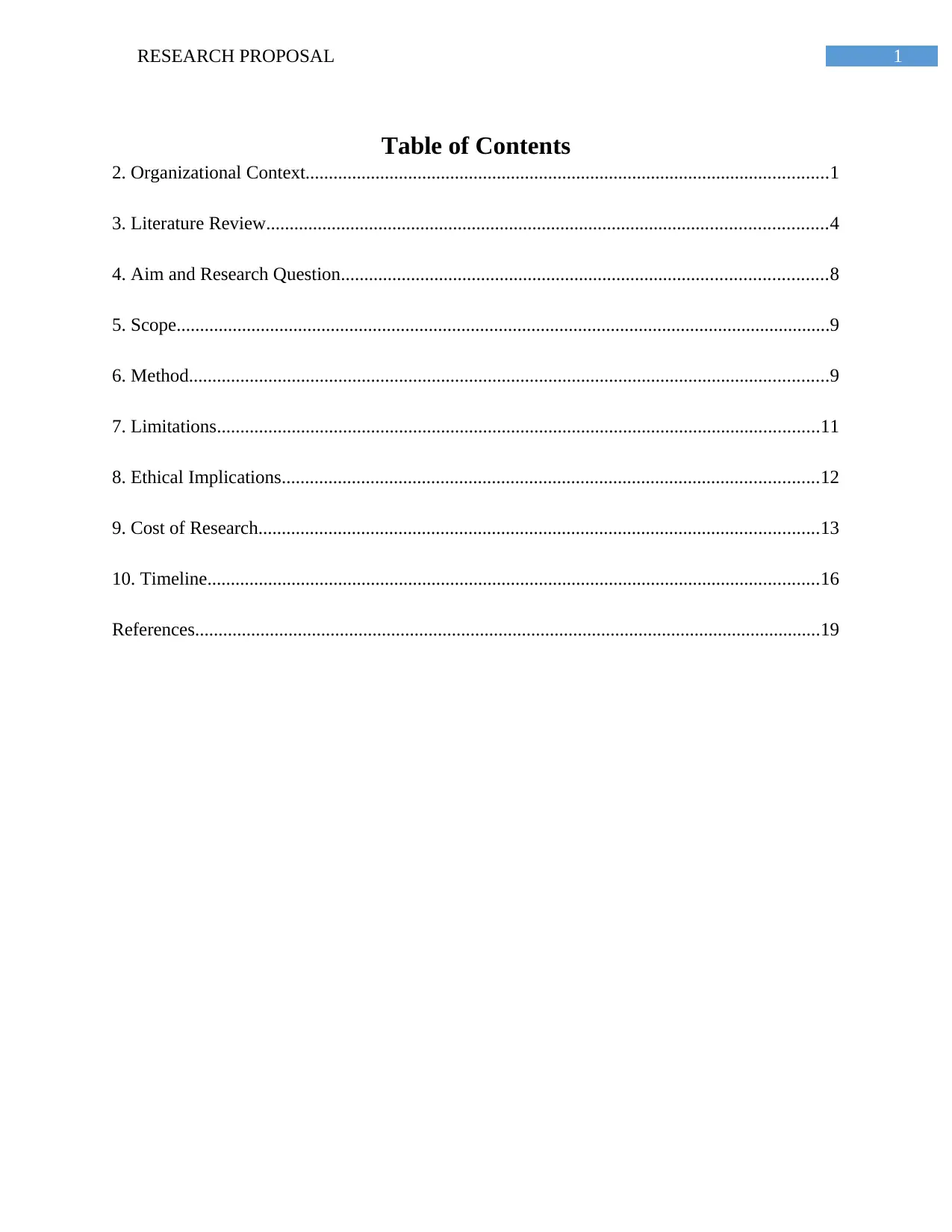
1RESEARCH PROPOSAL
Table of Contents
2. Organizational Context................................................................................................................1
3. Literature Review........................................................................................................................4
4. Aim and Research Question........................................................................................................8
5. Scope............................................................................................................................................9
6. Method.........................................................................................................................................9
7. Limitations.................................................................................................................................11
8. Ethical Implications...................................................................................................................12
9. Cost of Research........................................................................................................................13
10. Timeline...................................................................................................................................16
References......................................................................................................................................19
Table of Contents
2. Organizational Context................................................................................................................1
3. Literature Review........................................................................................................................4
4. Aim and Research Question........................................................................................................8
5. Scope............................................................................................................................................9
6. Method.........................................................................................................................................9
7. Limitations.................................................................................................................................11
8. Ethical Implications...................................................................................................................12
9. Cost of Research........................................................................................................................13
10. Timeline...................................................................................................................................16
References......................................................................................................................................19
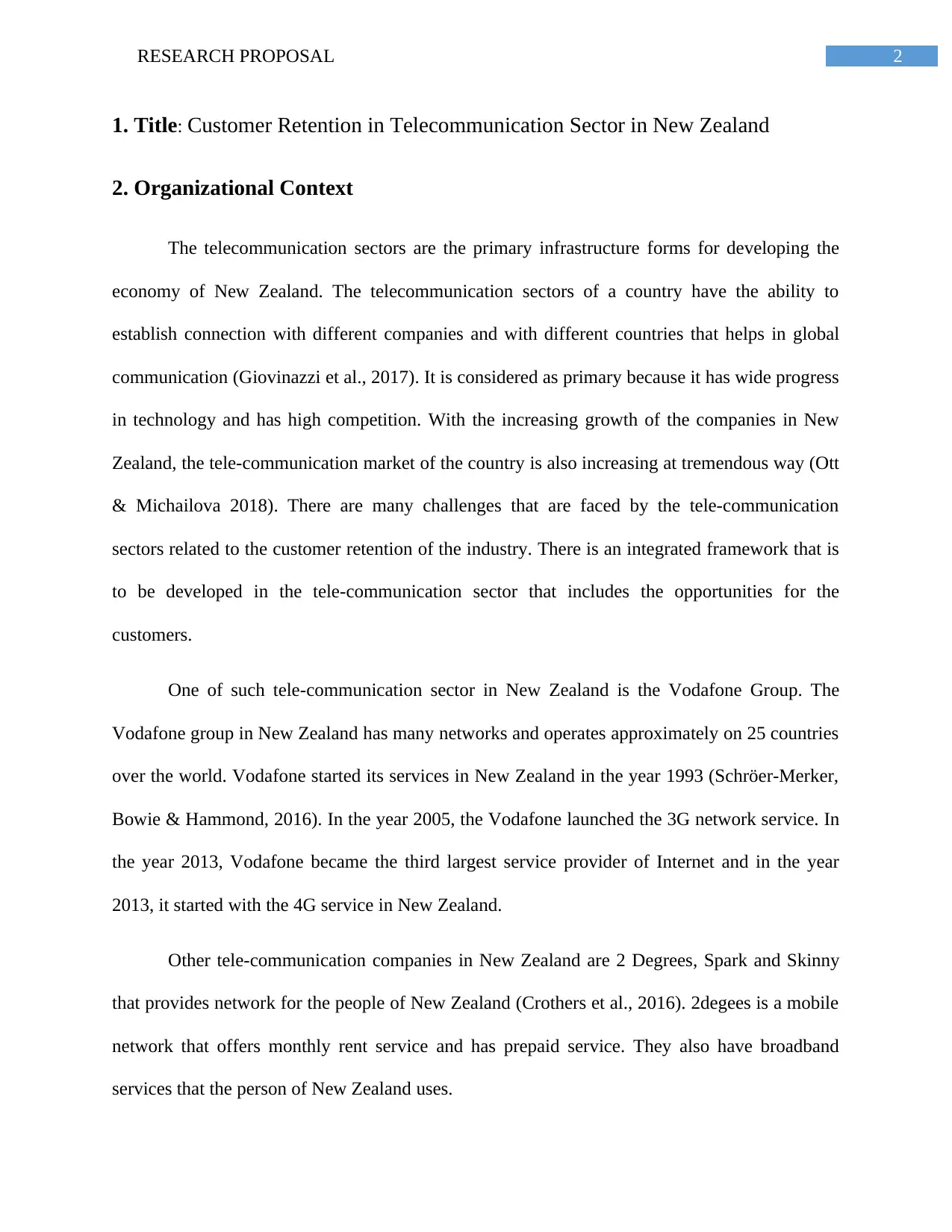
2RESEARCH PROPOSAL
1. Title: Customer Retention in Telecommunication Sector in New Zealand
2. Organizational Context
The telecommunication sectors are the primary infrastructure forms for developing the
economy of New Zealand. The telecommunication sectors of a country have the ability to
establish connection with different companies and with different countries that helps in global
communication (Giovinazzi et al., 2017). It is considered as primary because it has wide progress
in technology and has high competition. With the increasing growth of the companies in New
Zealand, the tele-communication market of the country is also increasing at tremendous way (Ott
& Michailova 2018). There are many challenges that are faced by the tele-communication
sectors related to the customer retention of the industry. There is an integrated framework that is
to be developed in the tele-communication sector that includes the opportunities for the
customers.
One of such tele-communication sector in New Zealand is the Vodafone Group. The
Vodafone group in New Zealand has many networks and operates approximately on 25 countries
over the world. Vodafone started its services in New Zealand in the year 1993 (Schröer-Merker,
Bowie & Hammond, 2016). In the year 2005, the Vodafone launched the 3G network service. In
the year 2013, Vodafone became the third largest service provider of Internet and in the year
2013, it started with the 4G service in New Zealand.
Other tele-communication companies in New Zealand are 2 Degrees, Spark and Skinny
that provides network for the people of New Zealand (Crothers et al., 2016). 2degees is a mobile
network that offers monthly rent service and has prepaid service. They also have broadband
services that the person of New Zealand uses.
1. Title: Customer Retention in Telecommunication Sector in New Zealand
2. Organizational Context
The telecommunication sectors are the primary infrastructure forms for developing the
economy of New Zealand. The telecommunication sectors of a country have the ability to
establish connection with different companies and with different countries that helps in global
communication (Giovinazzi et al., 2017). It is considered as primary because it has wide progress
in technology and has high competition. With the increasing growth of the companies in New
Zealand, the tele-communication market of the country is also increasing at tremendous way (Ott
& Michailova 2018). There are many challenges that are faced by the tele-communication
sectors related to the customer retention of the industry. There is an integrated framework that is
to be developed in the tele-communication sector that includes the opportunities for the
customers.
One of such tele-communication sector in New Zealand is the Vodafone Group. The
Vodafone group in New Zealand has many networks and operates approximately on 25 countries
over the world. Vodafone started its services in New Zealand in the year 1993 (Schröer-Merker,
Bowie & Hammond, 2016). In the year 2005, the Vodafone launched the 3G network service. In
the year 2013, Vodafone became the third largest service provider of Internet and in the year
2013, it started with the 4G service in New Zealand.
Other tele-communication companies in New Zealand are 2 Degrees, Spark and Skinny
that provides network for the people of New Zealand (Crothers et al., 2016). 2degees is a mobile
network that offers monthly rent service and has prepaid service. They also have broadband
services that the person of New Zealand uses.
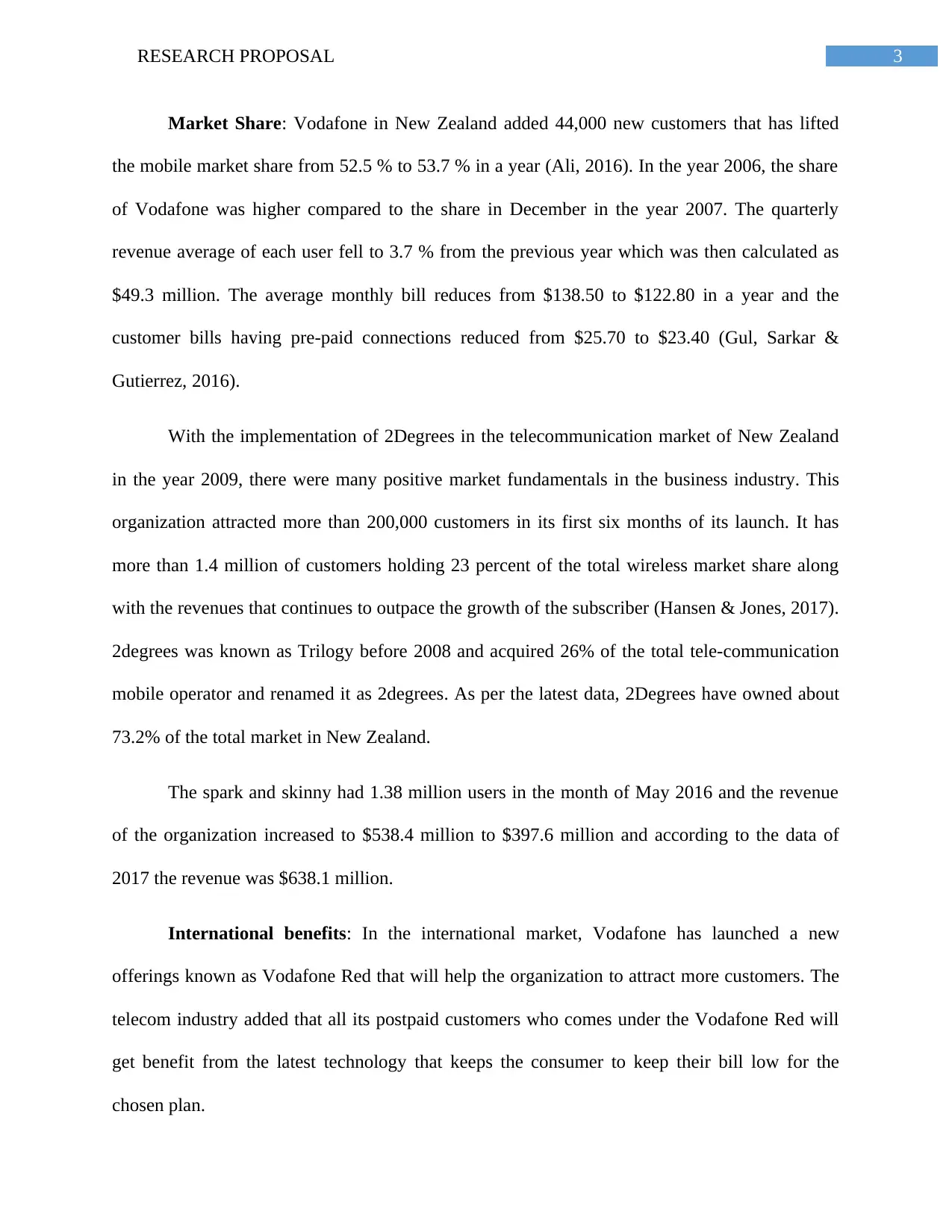
3RESEARCH PROPOSAL
Market Share: Vodafone in New Zealand added 44,000 new customers that has lifted
the mobile market share from 52.5 % to 53.7 % in a year (Ali, 2016). In the year 2006, the share
of Vodafone was higher compared to the share in December in the year 2007. The quarterly
revenue average of each user fell to 3.7 % from the previous year which was then calculated as
$49.3 million. The average monthly bill reduces from $138.50 to $122.80 in a year and the
customer bills having pre-paid connections reduced from $25.70 to $23.40 (Gul, Sarkar &
Gutierrez, 2016).
With the implementation of 2Degrees in the telecommunication market of New Zealand
in the year 2009, there were many positive market fundamentals in the business industry. This
organization attracted more than 200,000 customers in its first six months of its launch. It has
more than 1.4 million of customers holding 23 percent of the total wireless market share along
with the revenues that continues to outpace the growth of the subscriber (Hansen & Jones, 2017).
2degrees was known as Trilogy before 2008 and acquired 26% of the total tele-communication
mobile operator and renamed it as 2degrees. As per the latest data, 2Degrees have owned about
73.2% of the total market in New Zealand.
The spark and skinny had 1.38 million users in the month of May 2016 and the revenue
of the organization increased to $538.4 million to $397.6 million and according to the data of
2017 the revenue was $638.1 million.
International benefits: In the international market, Vodafone has launched a new
offerings known as Vodafone Red that will help the organization to attract more customers. The
telecom industry added that all its postpaid customers who comes under the Vodafone Red will
get benefit from the latest technology that keeps the consumer to keep their bill low for the
chosen plan.
Market Share: Vodafone in New Zealand added 44,000 new customers that has lifted
the mobile market share from 52.5 % to 53.7 % in a year (Ali, 2016). In the year 2006, the share
of Vodafone was higher compared to the share in December in the year 2007. The quarterly
revenue average of each user fell to 3.7 % from the previous year which was then calculated as
$49.3 million. The average monthly bill reduces from $138.50 to $122.80 in a year and the
customer bills having pre-paid connections reduced from $25.70 to $23.40 (Gul, Sarkar &
Gutierrez, 2016).
With the implementation of 2Degrees in the telecommunication market of New Zealand
in the year 2009, there were many positive market fundamentals in the business industry. This
organization attracted more than 200,000 customers in its first six months of its launch. It has
more than 1.4 million of customers holding 23 percent of the total wireless market share along
with the revenues that continues to outpace the growth of the subscriber (Hansen & Jones, 2017).
2degrees was known as Trilogy before 2008 and acquired 26% of the total tele-communication
mobile operator and renamed it as 2degrees. As per the latest data, 2Degrees have owned about
73.2% of the total market in New Zealand.
The spark and skinny had 1.38 million users in the month of May 2016 and the revenue
of the organization increased to $538.4 million to $397.6 million and according to the data of
2017 the revenue was $638.1 million.
International benefits: In the international market, Vodafone has launched a new
offerings known as Vodafone Red that will help the organization to attract more customers. The
telecom industry added that all its postpaid customers who comes under the Vodafone Red will
get benefit from the latest technology that keeps the consumer to keep their bill low for the
chosen plan.
Secure Best Marks with AI Grader
Need help grading? Try our AI Grader for instant feedback on your assignments.
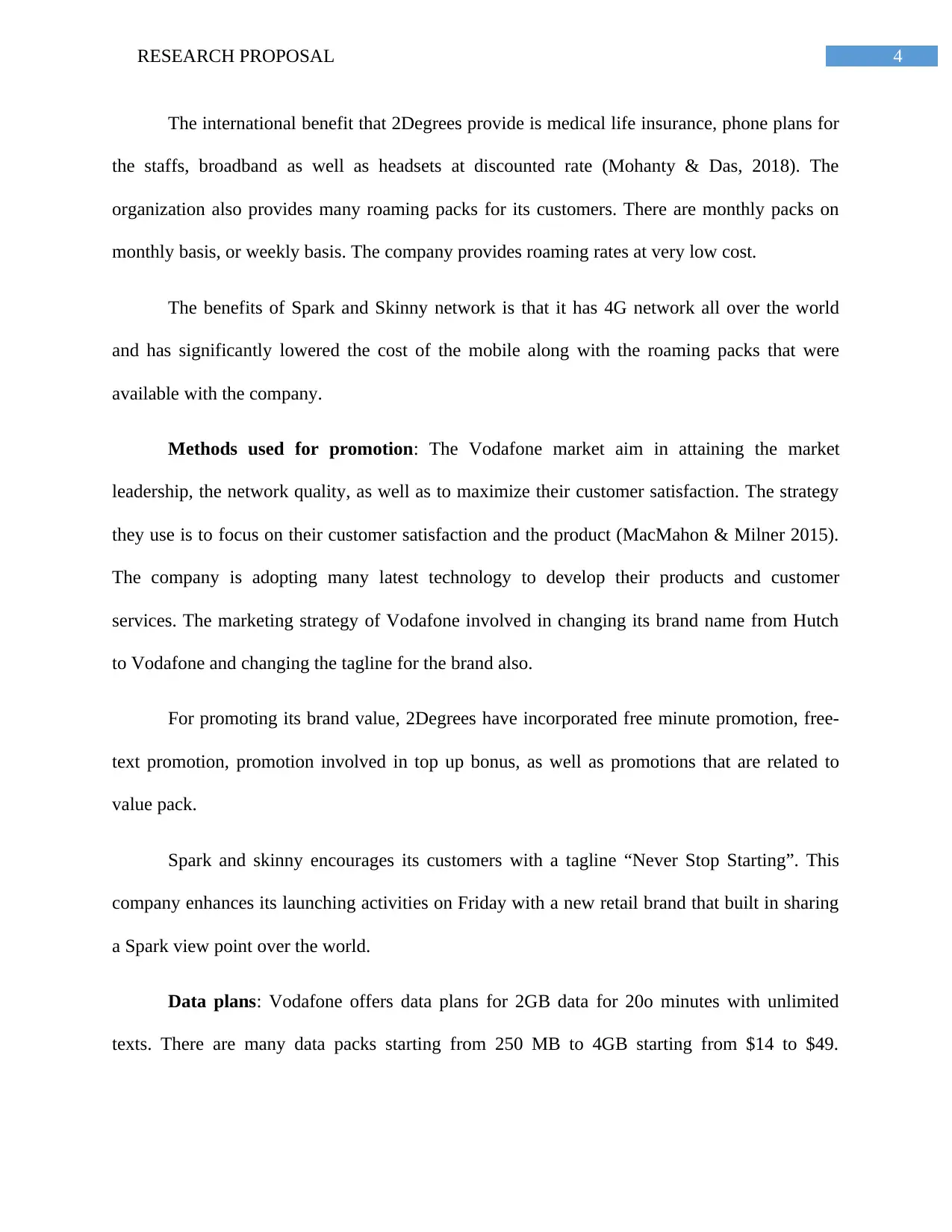
4RESEARCH PROPOSAL
The international benefit that 2Degrees provide is medical life insurance, phone plans for
the staffs, broadband as well as headsets at discounted rate (Mohanty & Das, 2018). The
organization also provides many roaming packs for its customers. There are monthly packs on
monthly basis, or weekly basis. The company provides roaming rates at very low cost.
The benefits of Spark and Skinny network is that it has 4G network all over the world
and has significantly lowered the cost of the mobile along with the roaming packs that were
available with the company.
Methods used for promotion: The Vodafone market aim in attaining the market
leadership, the network quality, as well as to maximize their customer satisfaction. The strategy
they use is to focus on their customer satisfaction and the product (MacMahon & Milner 2015).
The company is adopting many latest technology to develop their products and customer
services. The marketing strategy of Vodafone involved in changing its brand name from Hutch
to Vodafone and changing the tagline for the brand also.
For promoting its brand value, 2Degrees have incorporated free minute promotion, free-
text promotion, promotion involved in top up bonus, as well as promotions that are related to
value pack.
Spark and skinny encourages its customers with a tagline “Never Stop Starting”. This
company enhances its launching activities on Friday with a new retail brand that built in sharing
a Spark view point over the world.
Data plans: Vodafone offers data plans for 2GB data for 20o minutes with unlimited
texts. There are many data packs starting from 250 MB to 4GB starting from $14 to $49.
The international benefit that 2Degrees provide is medical life insurance, phone plans for
the staffs, broadband as well as headsets at discounted rate (Mohanty & Das, 2018). The
organization also provides many roaming packs for its customers. There are monthly packs on
monthly basis, or weekly basis. The company provides roaming rates at very low cost.
The benefits of Spark and Skinny network is that it has 4G network all over the world
and has significantly lowered the cost of the mobile along with the roaming packs that were
available with the company.
Methods used for promotion: The Vodafone market aim in attaining the market
leadership, the network quality, as well as to maximize their customer satisfaction. The strategy
they use is to focus on their customer satisfaction and the product (MacMahon & Milner 2015).
The company is adopting many latest technology to develop their products and customer
services. The marketing strategy of Vodafone involved in changing its brand name from Hutch
to Vodafone and changing the tagline for the brand also.
For promoting its brand value, 2Degrees have incorporated free minute promotion, free-
text promotion, promotion involved in top up bonus, as well as promotions that are related to
value pack.
Spark and skinny encourages its customers with a tagline “Never Stop Starting”. This
company enhances its launching activities on Friday with a new retail brand that built in sharing
a Spark view point over the world.
Data plans: Vodafone offers data plans for 2GB data for 20o minutes with unlimited
texts. There are many data packs starting from 250 MB to 4GB starting from $14 to $49.
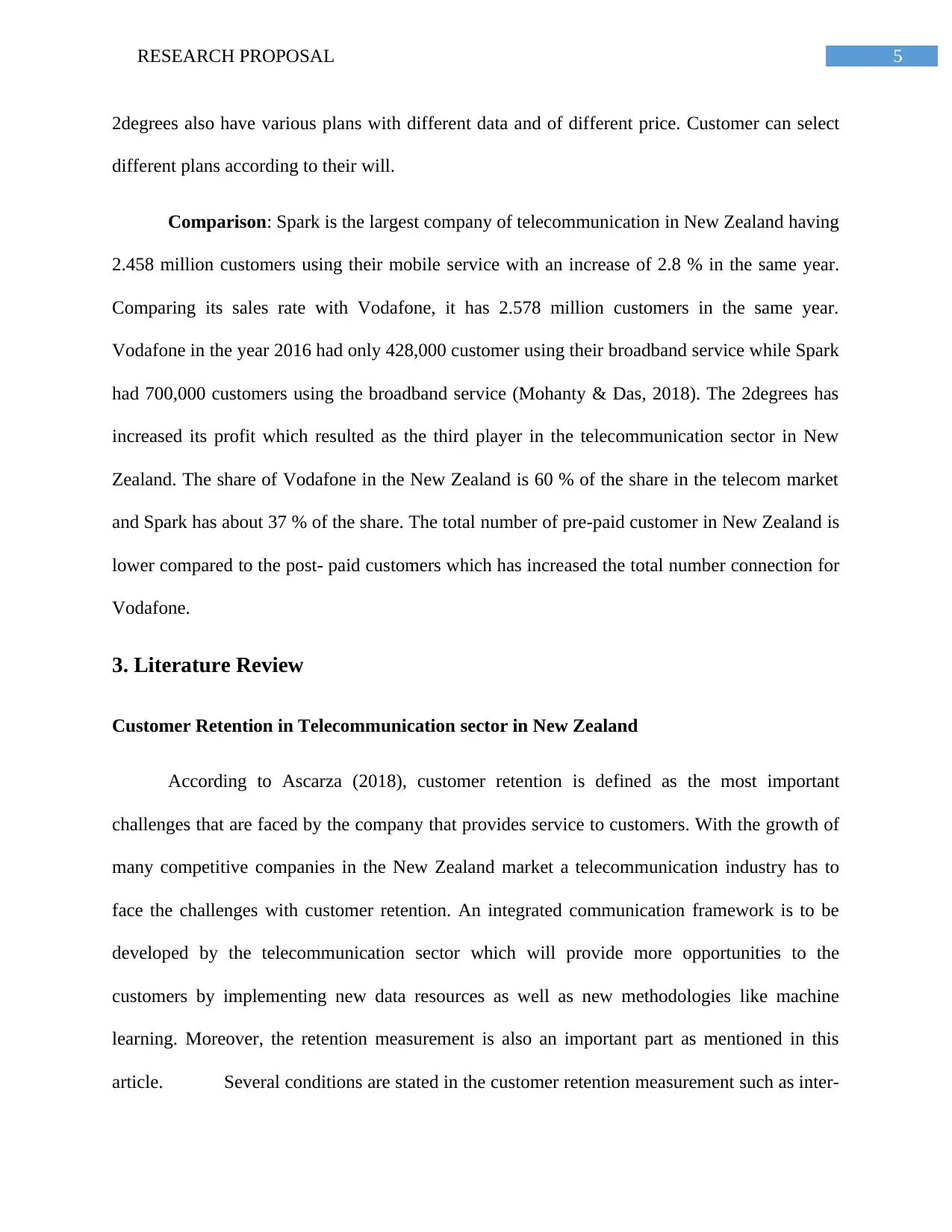
5RESEARCH PROPOSAL
2degrees also have various plans with different data and of different price. Customer can select
different plans according to their will.
Comparison: Spark is the largest company of telecommunication in New Zealand having
2.458 million customers using their mobile service with an increase of 2.8 % in the same year.
Comparing its sales rate with Vodafone, it has 2.578 million customers in the same year.
Vodafone in the year 2016 had only 428,000 customer using their broadband service while Spark
had 700,000 customers using the broadband service (Mohanty & Das, 2018). The 2degrees has
increased its profit which resulted as the third player in the telecommunication sector in New
Zealand. The share of Vodafone in the New Zealand is 60 % of the share in the telecom market
and Spark has about 37 % of the share. The total number of pre-paid customer in New Zealand is
lower compared to the post- paid customers which has increased the total number connection for
Vodafone.
3. Literature Review
Customer Retention in Telecommunication sector in New Zealand
According to Ascarza (2018), customer retention is defined as the most important
challenges that are faced by the company that provides service to customers. With the growth of
many competitive companies in the New Zealand market a telecommunication industry has to
face the challenges with customer retention. An integrated communication framework is to be
developed by the telecommunication sector which will provide more opportunities to the
customers by implementing new data resources as well as new methodologies like machine
learning. Moreover, the retention measurement is also an important part as mentioned in this
article. Several conditions are stated in the customer retention measurement such as inter-
2degrees also have various plans with different data and of different price. Customer can select
different plans according to their will.
Comparison: Spark is the largest company of telecommunication in New Zealand having
2.458 million customers using their mobile service with an increase of 2.8 % in the same year.
Comparing its sales rate with Vodafone, it has 2.578 million customers in the same year.
Vodafone in the year 2016 had only 428,000 customer using their broadband service while Spark
had 700,000 customers using the broadband service (Mohanty & Das, 2018). The 2degrees has
increased its profit which resulted as the third player in the telecommunication sector in New
Zealand. The share of Vodafone in the New Zealand is 60 % of the share in the telecom market
and Spark has about 37 % of the share. The total number of pre-paid customer in New Zealand is
lower compared to the post- paid customers which has increased the total number connection for
Vodafone.
3. Literature Review
Customer Retention in Telecommunication sector in New Zealand
According to Ascarza (2018), customer retention is defined as the most important
challenges that are faced by the company that provides service to customers. With the growth of
many competitive companies in the New Zealand market a telecommunication industry has to
face the challenges with customer retention. An integrated communication framework is to be
developed by the telecommunication sector which will provide more opportunities to the
customers by implementing new data resources as well as new methodologies like machine
learning. Moreover, the retention measurement is also an important part as mentioned in this
article. Several conditions are stated in the customer retention measurement such as inter-
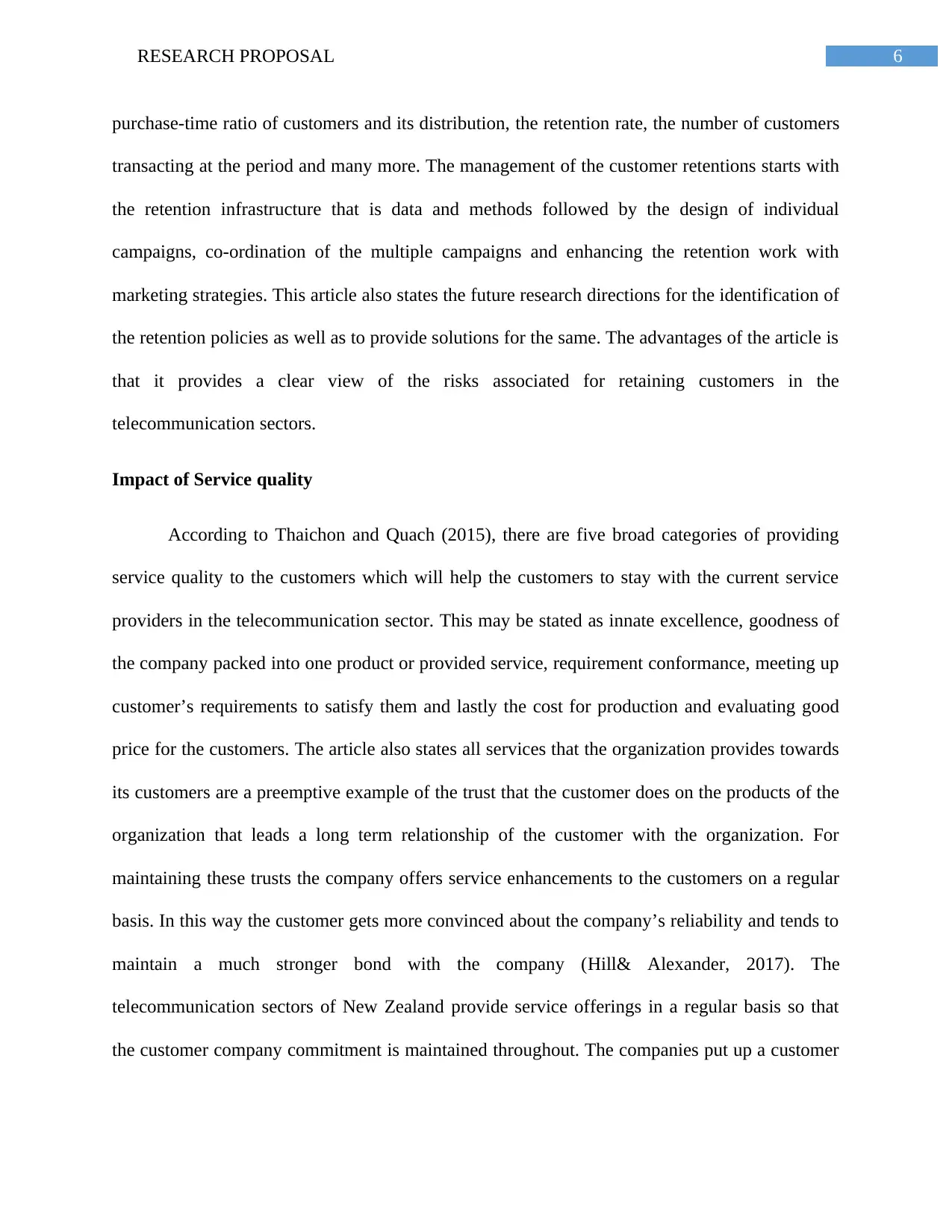
6RESEARCH PROPOSAL
purchase-time ratio of customers and its distribution, the retention rate, the number of customers
transacting at the period and many more. The management of the customer retentions starts with
the retention infrastructure that is data and methods followed by the design of individual
campaigns, co-ordination of the multiple campaigns and enhancing the retention work with
marketing strategies. This article also states the future research directions for the identification of
the retention policies as well as to provide solutions for the same. The advantages of the article is
that it provides a clear view of the risks associated for retaining customers in the
telecommunication sectors.
Impact of Service quality
According to Thaichon and Quach (2015), there are five broad categories of providing
service quality to the customers which will help the customers to stay with the current service
providers in the telecommunication sector. This may be stated as innate excellence, goodness of
the company packed into one product or provided service, requirement conformance, meeting up
customer’s requirements to satisfy them and lastly the cost for production and evaluating good
price for the customers. The article also states all services that the organization provides towards
its customers are a preemptive example of the trust that the customer does on the products of the
organization that leads a long term relationship of the customer with the organization. For
maintaining these trusts the company offers service enhancements to the customers on a regular
basis. In this way the customer gets more convinced about the company’s reliability and tends to
maintain a much stronger bond with the company (Hill& Alexander, 2017). The
telecommunication sectors of New Zealand provide service offerings in a regular basis so that
the customer company commitment is maintained throughout. The companies put up a customer
purchase-time ratio of customers and its distribution, the retention rate, the number of customers
transacting at the period and many more. The management of the customer retentions starts with
the retention infrastructure that is data and methods followed by the design of individual
campaigns, co-ordination of the multiple campaigns and enhancing the retention work with
marketing strategies. This article also states the future research directions for the identification of
the retention policies as well as to provide solutions for the same. The advantages of the article is
that it provides a clear view of the risks associated for retaining customers in the
telecommunication sectors.
Impact of Service quality
According to Thaichon and Quach (2015), there are five broad categories of providing
service quality to the customers which will help the customers to stay with the current service
providers in the telecommunication sector. This may be stated as innate excellence, goodness of
the company packed into one product or provided service, requirement conformance, meeting up
customer’s requirements to satisfy them and lastly the cost for production and evaluating good
price for the customers. The article also states all services that the organization provides towards
its customers are a preemptive example of the trust that the customer does on the products of the
organization that leads a long term relationship of the customer with the organization. For
maintaining these trusts the company offers service enhancements to the customers on a regular
basis. In this way the customer gets more convinced about the company’s reliability and tends to
maintain a much stronger bond with the company (Hill& Alexander, 2017). The
telecommunication sectors of New Zealand provide service offerings in a regular basis so that
the customer company commitment is maintained throughout. The companies put up a customer
Paraphrase This Document
Need a fresh take? Get an instant paraphrase of this document with our AI Paraphraser
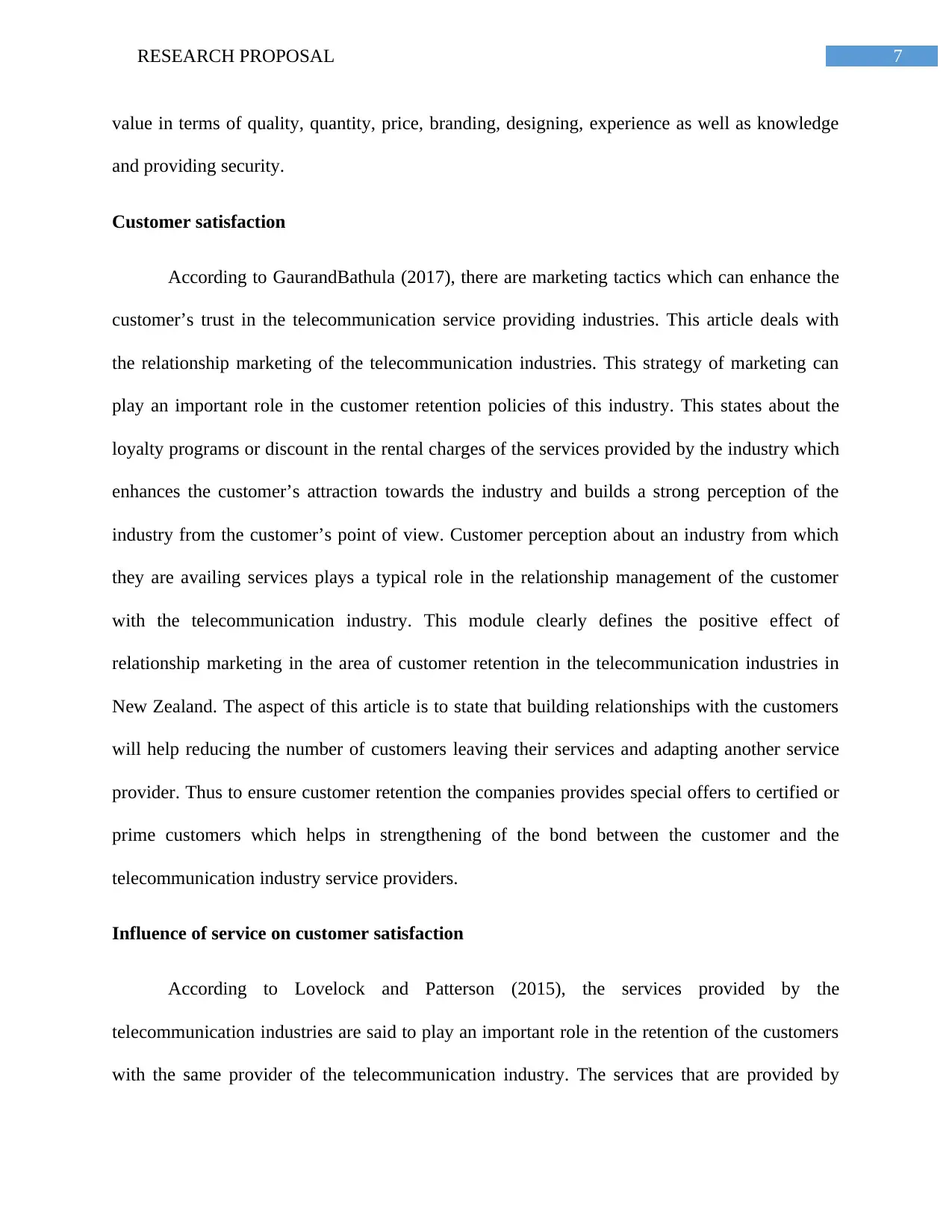
7RESEARCH PROPOSAL
value in terms of quality, quantity, price, branding, designing, experience as well as knowledge
and providing security.
Customer satisfaction
According to GaurandBathula (2017), there are marketing tactics which can enhance the
customer’s trust in the telecommunication service providing industries. This article deals with
the relationship marketing of the telecommunication industries. This strategy of marketing can
play an important role in the customer retention policies of this industry. This states about the
loyalty programs or discount in the rental charges of the services provided by the industry which
enhances the customer’s attraction towards the industry and builds a strong perception of the
industry from the customer’s point of view. Customer perception about an industry from which
they are availing services plays a typical role in the relationship management of the customer
with the telecommunication industry. This module clearly defines the positive effect of
relationship marketing in the area of customer retention in the telecommunication industries in
New Zealand. The aspect of this article is to state that building relationships with the customers
will help reducing the number of customers leaving their services and adapting another service
provider. Thus to ensure customer retention the companies provides special offers to certified or
prime customers which helps in strengthening of the bond between the customer and the
telecommunication industry service providers.
Influence of service on customer satisfaction
According to Lovelock and Patterson (2015), the services provided by the
telecommunication industries are said to play an important role in the retention of the customers
with the same provider of the telecommunication industry. The services that are provided by
value in terms of quality, quantity, price, branding, designing, experience as well as knowledge
and providing security.
Customer satisfaction
According to GaurandBathula (2017), there are marketing tactics which can enhance the
customer’s trust in the telecommunication service providing industries. This article deals with
the relationship marketing of the telecommunication industries. This strategy of marketing can
play an important role in the customer retention policies of this industry. This states about the
loyalty programs or discount in the rental charges of the services provided by the industry which
enhances the customer’s attraction towards the industry and builds a strong perception of the
industry from the customer’s point of view. Customer perception about an industry from which
they are availing services plays a typical role in the relationship management of the customer
with the telecommunication industry. This module clearly defines the positive effect of
relationship marketing in the area of customer retention in the telecommunication industries in
New Zealand. The aspect of this article is to state that building relationships with the customers
will help reducing the number of customers leaving their services and adapting another service
provider. Thus to ensure customer retention the companies provides special offers to certified or
prime customers which helps in strengthening of the bond between the customer and the
telecommunication industry service providers.
Influence of service on customer satisfaction
According to Lovelock and Patterson (2015), the services provided by the
telecommunication industries are said to play an important role in the retention of the customers
with the same provider of the telecommunication industry. The services that are provided by
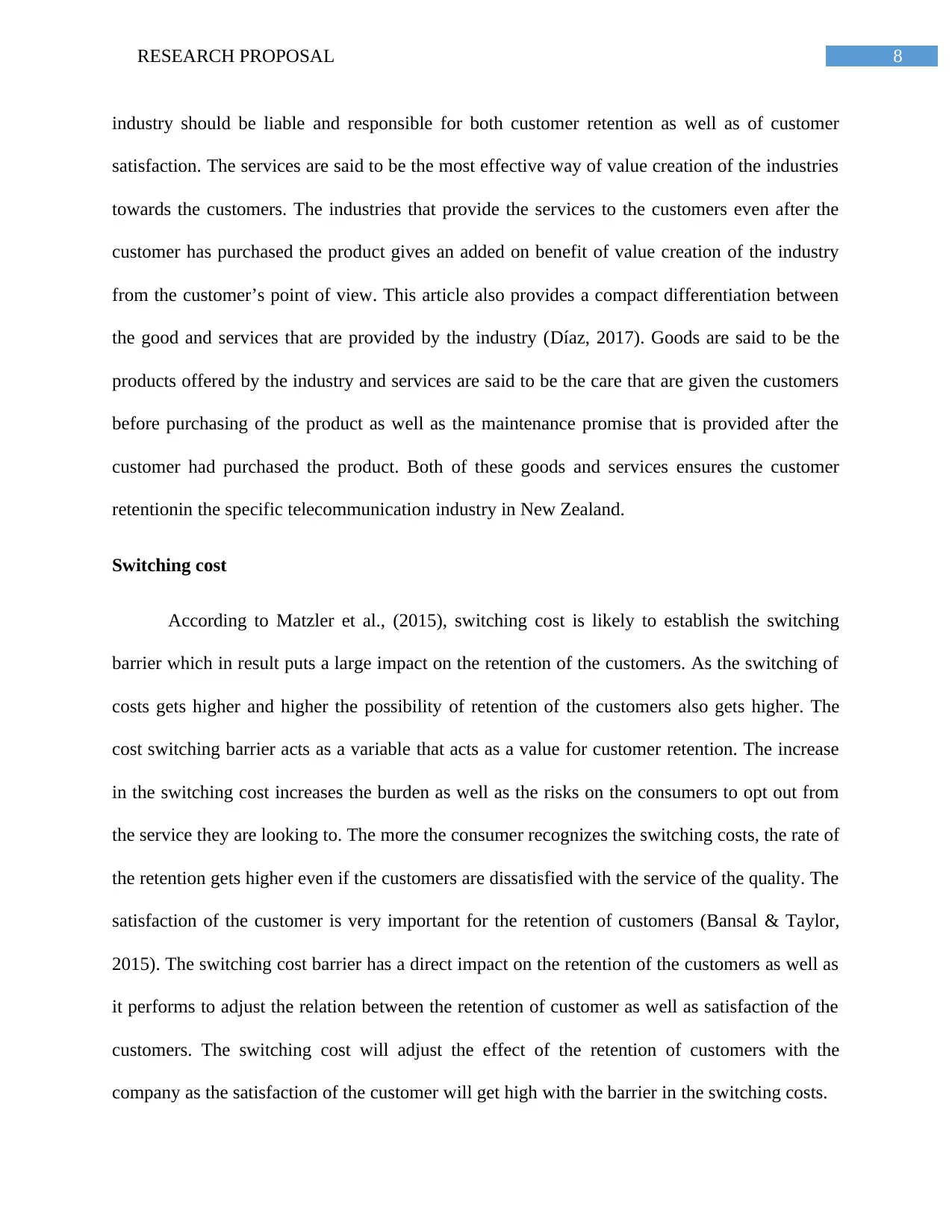
8RESEARCH PROPOSAL
industry should be liable and responsible for both customer retention as well as of customer
satisfaction. The services are said to be the most effective way of value creation of the industries
towards the customers. The industries that provide the services to the customers even after the
customer has purchased the product gives an added on benefit of value creation of the industry
from the customer’s point of view. This article also provides a compact differentiation between
the good and services that are provided by the industry (Díaz, 2017). Goods are said to be the
products offered by the industry and services are said to be the care that are given the customers
before purchasing of the product as well as the maintenance promise that is provided after the
customer had purchased the product. Both of these goods and services ensures the customer
retentionin the specific telecommunication industry in New Zealand.
Switching cost
According to Matzler et al., (2015), switching cost is likely to establish the switching
barrier which in result puts a large impact on the retention of the customers. As the switching of
costs gets higher and higher the possibility of retention of the customers also gets higher. The
cost switching barrier acts as a variable that acts as a value for customer retention. The increase
in the switching cost increases the burden as well as the risks on the consumers to opt out from
the service they are looking to. The more the consumer recognizes the switching costs, the rate of
the retention gets higher even if the customers are dissatisfied with the service of the quality. The
satisfaction of the customer is very important for the retention of customers (Bansal & Taylor,
2015). The switching cost barrier has a direct impact on the retention of the customers as well as
it performs to adjust the relation between the retention of customer as well as satisfaction of the
customers. The switching cost will adjust the effect of the retention of customers with the
company as the satisfaction of the customer will get high with the barrier in the switching costs.
industry should be liable and responsible for both customer retention as well as of customer
satisfaction. The services are said to be the most effective way of value creation of the industries
towards the customers. The industries that provide the services to the customers even after the
customer has purchased the product gives an added on benefit of value creation of the industry
from the customer’s point of view. This article also provides a compact differentiation between
the good and services that are provided by the industry (Díaz, 2017). Goods are said to be the
products offered by the industry and services are said to be the care that are given the customers
before purchasing of the product as well as the maintenance promise that is provided after the
customer had purchased the product. Both of these goods and services ensures the customer
retentionin the specific telecommunication industry in New Zealand.
Switching cost
According to Matzler et al., (2015), switching cost is likely to establish the switching
barrier which in result puts a large impact on the retention of the customers. As the switching of
costs gets higher and higher the possibility of retention of the customers also gets higher. The
cost switching barrier acts as a variable that acts as a value for customer retention. The increase
in the switching cost increases the burden as well as the risks on the consumers to opt out from
the service they are looking to. The more the consumer recognizes the switching costs, the rate of
the retention gets higher even if the customers are dissatisfied with the service of the quality. The
satisfaction of the customer is very important for the retention of customers (Bansal & Taylor,
2015). The switching cost barrier has a direct impact on the retention of the customers as well as
it performs to adjust the relation between the retention of customer as well as satisfaction of the
customers. The switching cost will adjust the effect of the retention of customers with the
company as the satisfaction of the customer will get high with the barrier in the switching costs.
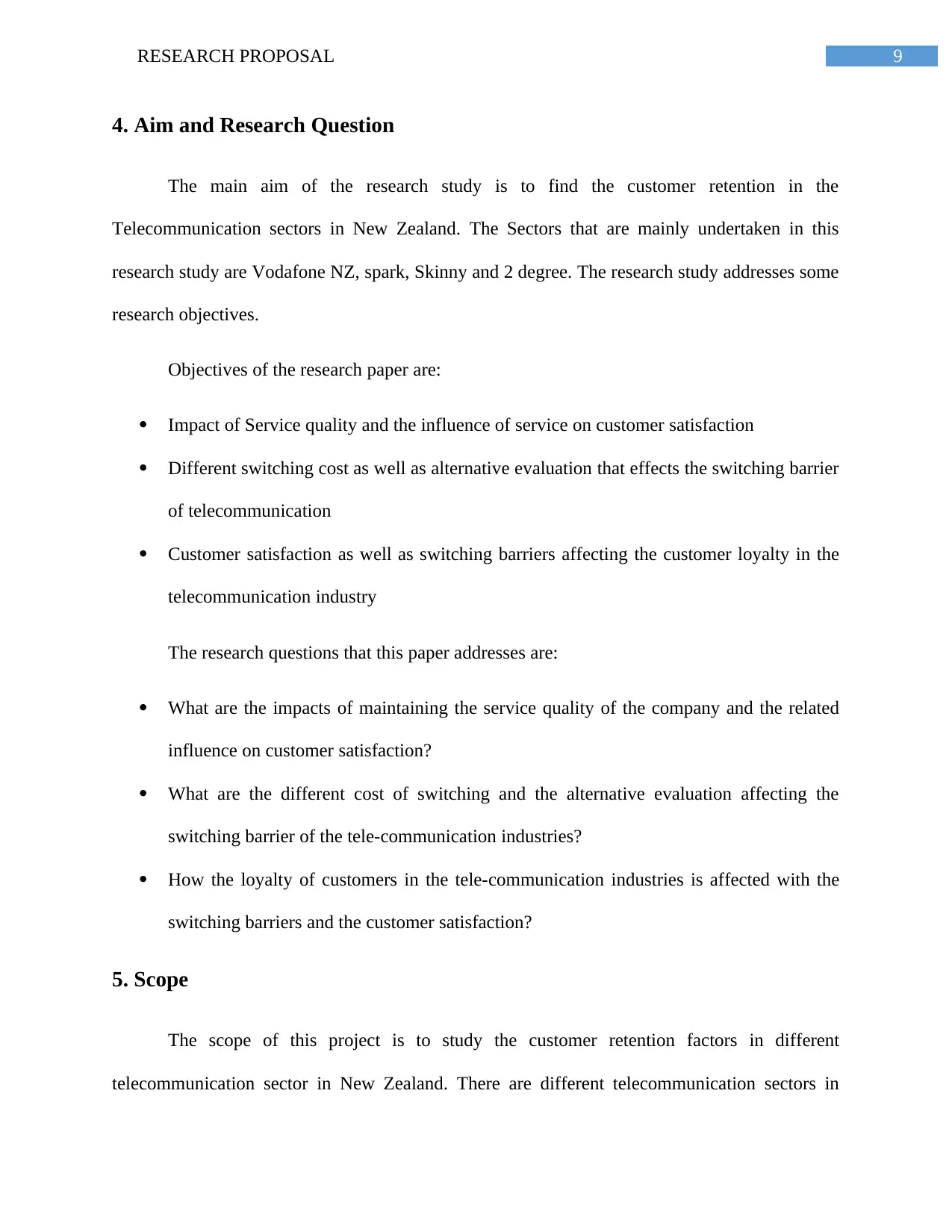
9RESEARCH PROPOSAL
4. Aim and Research Question
The main aim of the research study is to find the customer retention in the
Telecommunication sectors in New Zealand. The Sectors that are mainly undertaken in this
research study are Vodafone NZ, spark, Skinny and 2 degree. The research study addresses some
research objectives.
Objectives of the research paper are:
Impact of Service quality and the influence of service on customer satisfaction
Different switching cost as well as alternative evaluation that effects the switching barrier
of telecommunication
Customer satisfaction as well as switching barriers affecting the customer loyalty in the
telecommunication industry
The research questions that this paper addresses are:
What are the impacts of maintaining the service quality of the company and the related
influence on customer satisfaction?
What are the different cost of switching and the alternative evaluation affecting the
switching barrier of the tele-communication industries?
How the loyalty of customers in the tele-communication industries is affected with the
switching barriers and the customer satisfaction?
5. Scope
The scope of this project is to study the customer retention factors in different
telecommunication sector in New Zealand. There are different telecommunication sectors in
4. Aim and Research Question
The main aim of the research study is to find the customer retention in the
Telecommunication sectors in New Zealand. The Sectors that are mainly undertaken in this
research study are Vodafone NZ, spark, Skinny and 2 degree. The research study addresses some
research objectives.
Objectives of the research paper are:
Impact of Service quality and the influence of service on customer satisfaction
Different switching cost as well as alternative evaluation that effects the switching barrier
of telecommunication
Customer satisfaction as well as switching barriers affecting the customer loyalty in the
telecommunication industry
The research questions that this paper addresses are:
What are the impacts of maintaining the service quality of the company and the related
influence on customer satisfaction?
What are the different cost of switching and the alternative evaluation affecting the
switching barrier of the tele-communication industries?
How the loyalty of customers in the tele-communication industries is affected with the
switching barriers and the customer satisfaction?
5. Scope
The scope of this project is to study the customer retention factors in different
telecommunication sector in New Zealand. There are different telecommunication sectors in
Secure Best Marks with AI Grader
Need help grading? Try our AI Grader for instant feedback on your assignments.
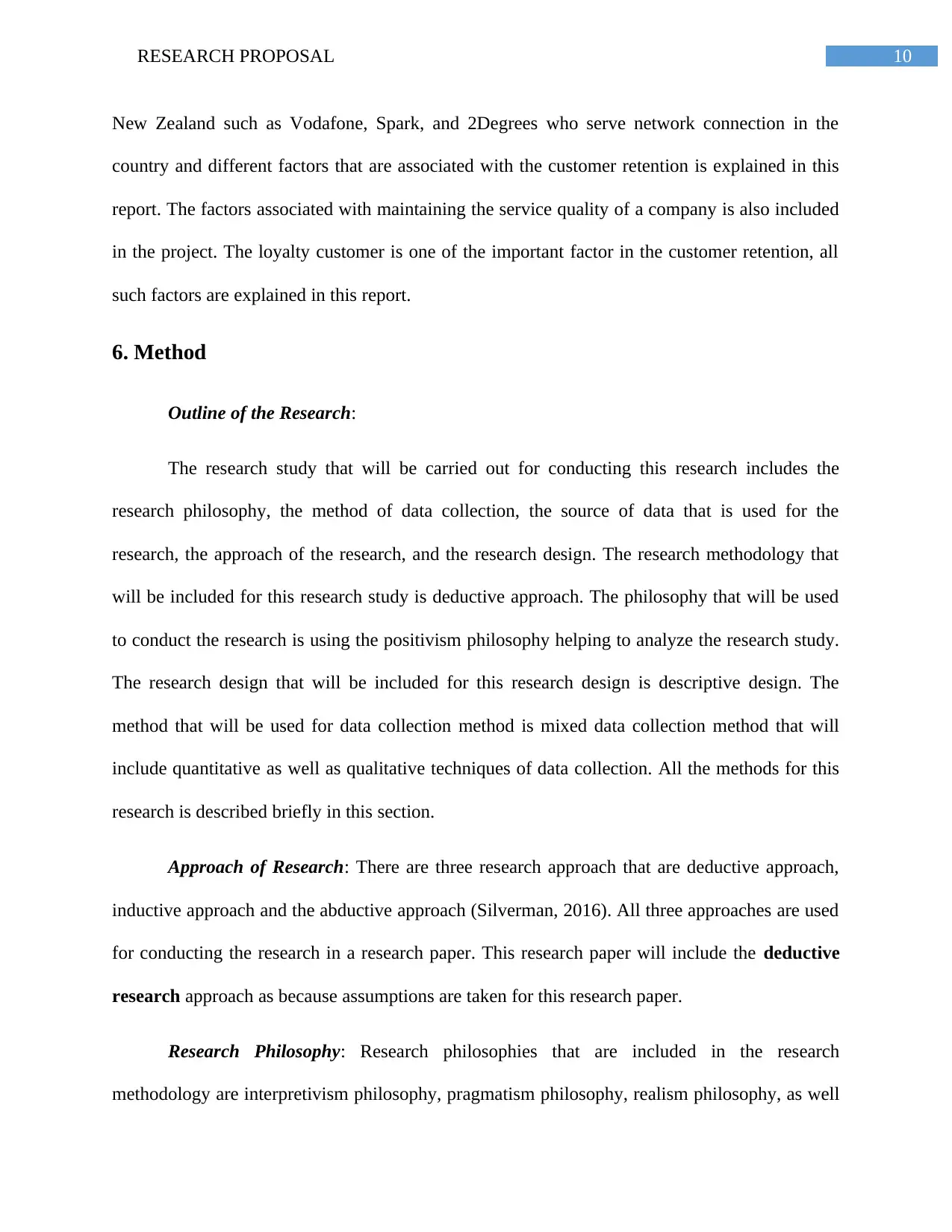
10RESEARCH PROPOSAL
New Zealand such as Vodafone, Spark, and 2Degrees who serve network connection in the
country and different factors that are associated with the customer retention is explained in this
report. The factors associated with maintaining the service quality of a company is also included
in the project. The loyalty customer is one of the important factor in the customer retention, all
such factors are explained in this report.
6. Method
Outline of the Research:
The research study that will be carried out for conducting this research includes the
research philosophy, the method of data collection, the source of data that is used for the
research, the approach of the research, and the research design. The research methodology that
will be included for this research study is deductive approach. The philosophy that will be used
to conduct the research is using the positivism philosophy helping to analyze the research study.
The research design that will be included for this research design is descriptive design. The
method that will be used for data collection method is mixed data collection method that will
include quantitative as well as qualitative techniques of data collection. All the methods for this
research is described briefly in this section.
Approach of Research: There are three research approach that are deductive approach,
inductive approach and the abductive approach (Silverman, 2016). All three approaches are used
for conducting the research in a research paper. This research paper will include the deductive
research approach as because assumptions are taken for this research paper.
Research Philosophy: Research philosophies that are included in the research
methodology are interpretivism philosophy, pragmatism philosophy, realism philosophy, as well
New Zealand such as Vodafone, Spark, and 2Degrees who serve network connection in the
country and different factors that are associated with the customer retention is explained in this
report. The factors associated with maintaining the service quality of a company is also included
in the project. The loyalty customer is one of the important factor in the customer retention, all
such factors are explained in this report.
6. Method
Outline of the Research:
The research study that will be carried out for conducting this research includes the
research philosophy, the method of data collection, the source of data that is used for the
research, the approach of the research, and the research design. The research methodology that
will be included for this research study is deductive approach. The philosophy that will be used
to conduct the research is using the positivism philosophy helping to analyze the research study.
The research design that will be included for this research design is descriptive design. The
method that will be used for data collection method is mixed data collection method that will
include quantitative as well as qualitative techniques of data collection. All the methods for this
research is described briefly in this section.
Approach of Research: There are three research approach that are deductive approach,
inductive approach and the abductive approach (Silverman, 2016). All three approaches are used
for conducting the research in a research paper. This research paper will include the deductive
research approach as because assumptions are taken for this research paper.
Research Philosophy: Research philosophies that are included in the research
methodology are interpretivism philosophy, pragmatism philosophy, realism philosophy, as well

11RESEARCH PROPOSAL
as positivism philosophy (Taylor, Bogdan & DeVault, 2015). The research philosophy that will
be used in this research paper will include positivism research philosophy. As this research will
have mixed research philosophy, the positivism research is the most appropriate research
philosophy.
Research Design: Design of research includes in research paper involves experimental
design, descriptive design for conducting the research and the exploratory design of conducting
the research (Mackey & Gass, 2015). The research design that will be used for carrying out this
research paper is descriptive research design. The customer retention in the tele-
communication sector in New Zealand will be carried out by the descriptive research design
(Flick, 2015). The problems that are related with the topic chosen will be addressed with the
descriptive research design. This particular research design used for explaining all the problems
are involved in the customer retention in tele-communication sector. The approach of this
research design describe the factors with this research paper is connected.
Data Collection Method: The data that are related with the customer retention in tele-
communication sector in New Zealand will be carried out through mixed method of data
collected. Mixed method of collecting the data includes the secondary as well as primary data
collection (Murphy, 2017). Secondary method of collecting the data includes collection of data
from different authors in the different books, journals, articles and blogs that are available online.
Primary method of collecting data includes collecting the data by carrying out survey or
interviews in the chosen organizations related to the topic. The survey can be done online or can
be done as conducting the interview. Questionnaires are made for conducting the survey and
respondents are selected for participating the survey (Bresler & Stake, 2017). The secondary
method of data collection will include both quantitative method and qualitative method of
as positivism philosophy (Taylor, Bogdan & DeVault, 2015). The research philosophy that will
be used in this research paper will include positivism research philosophy. As this research will
have mixed research philosophy, the positivism research is the most appropriate research
philosophy.
Research Design: Design of research includes in research paper involves experimental
design, descriptive design for conducting the research and the exploratory design of conducting
the research (Mackey & Gass, 2015). The research design that will be used for carrying out this
research paper is descriptive research design. The customer retention in the tele-
communication sector in New Zealand will be carried out by the descriptive research design
(Flick, 2015). The problems that are related with the topic chosen will be addressed with the
descriptive research design. This particular research design used for explaining all the problems
are involved in the customer retention in tele-communication sector. The approach of this
research design describe the factors with this research paper is connected.
Data Collection Method: The data that are related with the customer retention in tele-
communication sector in New Zealand will be carried out through mixed method of data
collected. Mixed method of collecting the data includes the secondary as well as primary data
collection (Murphy, 2017). Secondary method of collecting the data includes collection of data
from different authors in the different books, journals, articles and blogs that are available online.
Primary method of collecting data includes collecting the data by carrying out survey or
interviews in the chosen organizations related to the topic. The survey can be done online or can
be done as conducting the interview. Questionnaires are made for conducting the survey and
respondents are selected for participating the survey (Bresler & Stake, 2017). The secondary
method of data collection will include both quantitative method and qualitative method of
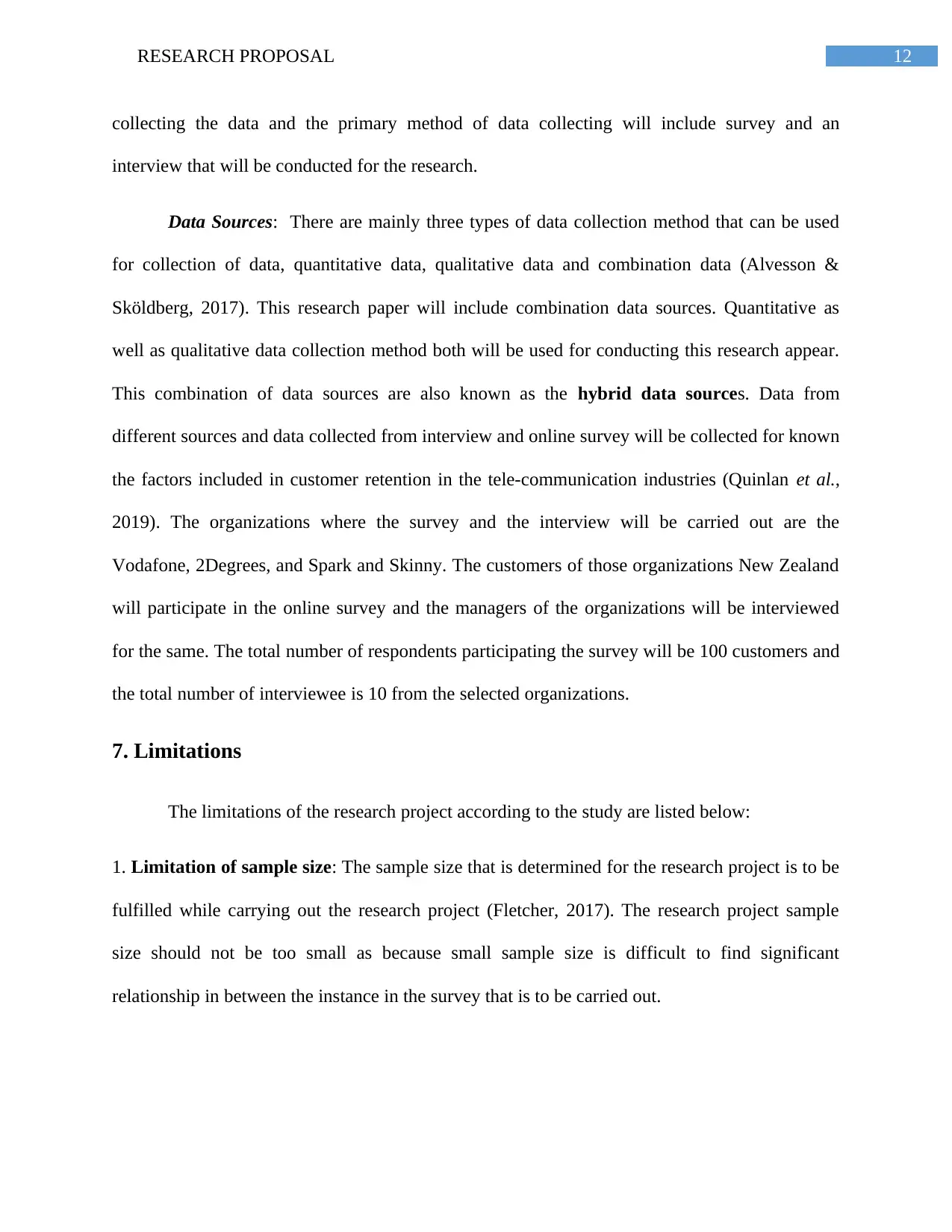
12RESEARCH PROPOSAL
collecting the data and the primary method of data collecting will include survey and an
interview that will be conducted for the research.
Data Sources: There are mainly three types of data collection method that can be used
for collection of data, quantitative data, qualitative data and combination data (Alvesson &
Sköldberg, 2017). This research paper will include combination data sources. Quantitative as
well as qualitative data collection method both will be used for conducting this research appear.
This combination of data sources are also known as the hybrid data sources. Data from
different sources and data collected from interview and online survey will be collected for known
the factors included in customer retention in the tele-communication industries (Quinlan et al.,
2019). The organizations where the survey and the interview will be carried out are the
Vodafone, 2Degrees, and Spark and Skinny. The customers of those organizations New Zealand
will participate in the online survey and the managers of the organizations will be interviewed
for the same. The total number of respondents participating the survey will be 100 customers and
the total number of interviewee is 10 from the selected organizations.
7. Limitations
The limitations of the research project according to the study are listed below:
1. Limitation of sample size: The sample size that is determined for the research project is to be
fulfilled while carrying out the research project (Fletcher, 2017). The research project sample
size should not be too small as because small sample size is difficult to find significant
relationship in between the instance in the survey that is to be carried out.
collecting the data and the primary method of data collecting will include survey and an
interview that will be conducted for the research.
Data Sources: There are mainly three types of data collection method that can be used
for collection of data, quantitative data, qualitative data and combination data (Alvesson &
Sköldberg, 2017). This research paper will include combination data sources. Quantitative as
well as qualitative data collection method both will be used for conducting this research appear.
This combination of data sources are also known as the hybrid data sources. Data from
different sources and data collected from interview and online survey will be collected for known
the factors included in customer retention in the tele-communication industries (Quinlan et al.,
2019). The organizations where the survey and the interview will be carried out are the
Vodafone, 2Degrees, and Spark and Skinny. The customers of those organizations New Zealand
will participate in the online survey and the managers of the organizations will be interviewed
for the same. The total number of respondents participating the survey will be 100 customers and
the total number of interviewee is 10 from the selected organizations.
7. Limitations
The limitations of the research project according to the study are listed below:
1. Limitation of sample size: The sample size that is determined for the research project is to be
fulfilled while carrying out the research project (Fletcher, 2017). The research project sample
size should not be too small as because small sample size is difficult to find significant
relationship in between the instance in the survey that is to be carried out.
Paraphrase This Document
Need a fresh take? Get an instant paraphrase of this document with our AI Paraphraser
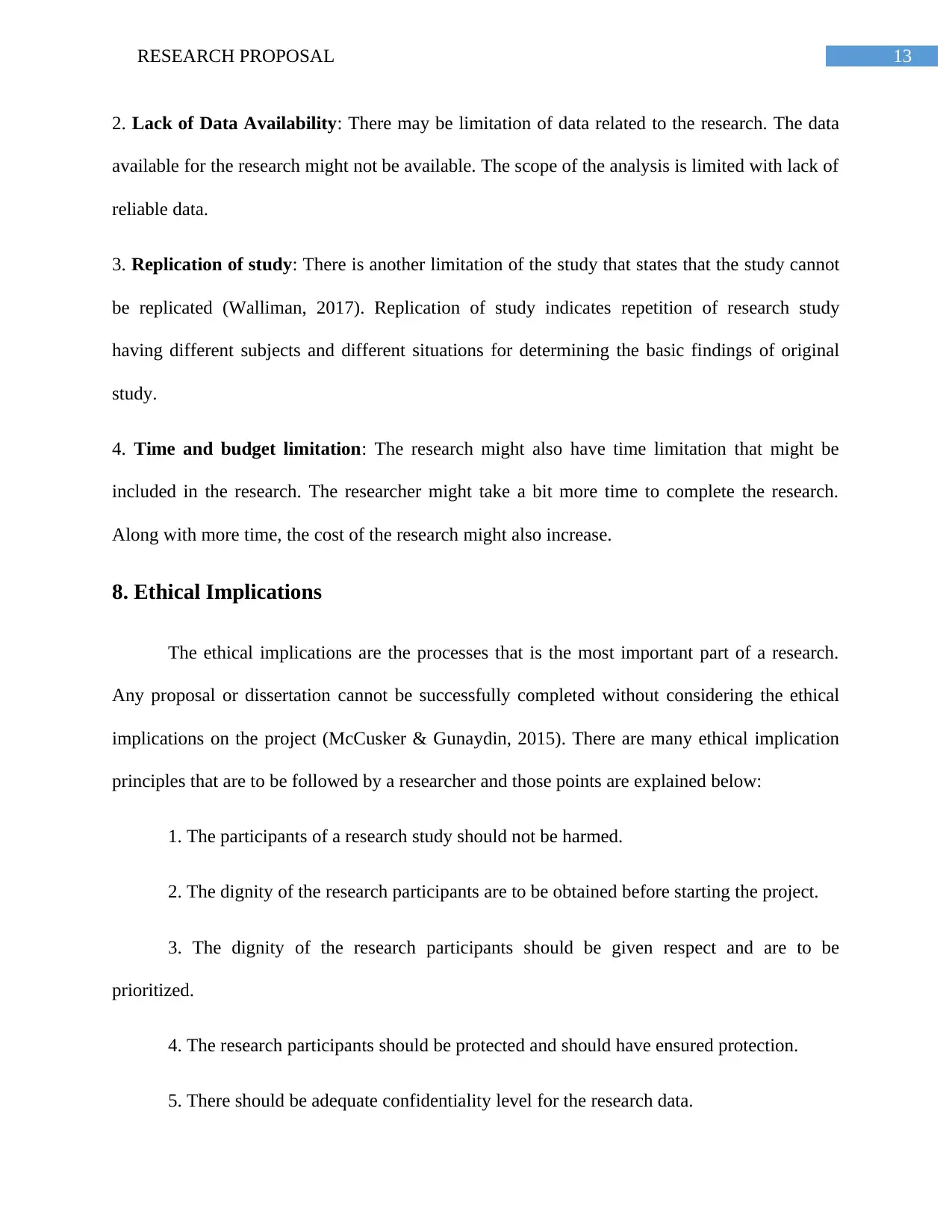
13RESEARCH PROPOSAL
2. Lack of Data Availability: There may be limitation of data related to the research. The data
available for the research might not be available. The scope of the analysis is limited with lack of
reliable data.
3. Replication of study: There is another limitation of the study that states that the study cannot
be replicated (Walliman, 2017). Replication of study indicates repetition of research study
having different subjects and different situations for determining the basic findings of original
study.
4. Time and budget limitation: The research might also have time limitation that might be
included in the research. The researcher might take a bit more time to complete the research.
Along with more time, the cost of the research might also increase.
8. Ethical Implications
The ethical implications are the processes that is the most important part of a research.
Any proposal or dissertation cannot be successfully completed without considering the ethical
implications on the project (McCusker & Gunaydin, 2015). There are many ethical implication
principles that are to be followed by a researcher and those points are explained below:
1. The participants of a research study should not be harmed.
2. The dignity of the research participants are to be obtained before starting the project.
3. The dignity of the research participants should be given respect and are to be
prioritized.
4. The research participants should be protected and should have ensured protection.
5. There should be adequate confidentiality level for the research data.
2. Lack of Data Availability: There may be limitation of data related to the research. The data
available for the research might not be available. The scope of the analysis is limited with lack of
reliable data.
3. Replication of study: There is another limitation of the study that states that the study cannot
be replicated (Walliman, 2017). Replication of study indicates repetition of research study
having different subjects and different situations for determining the basic findings of original
study.
4. Time and budget limitation: The research might also have time limitation that might be
included in the research. The researcher might take a bit more time to complete the research.
Along with more time, the cost of the research might also increase.
8. Ethical Implications
The ethical implications are the processes that is the most important part of a research.
Any proposal or dissertation cannot be successfully completed without considering the ethical
implications on the project (McCusker & Gunaydin, 2015). There are many ethical implication
principles that are to be followed by a researcher and those points are explained below:
1. The participants of a research study should not be harmed.
2. The dignity of the research participants are to be obtained before starting the project.
3. The dignity of the research participants should be given respect and are to be
prioritized.
4. The research participants should be protected and should have ensured protection.
5. There should be adequate confidentiality level for the research data.
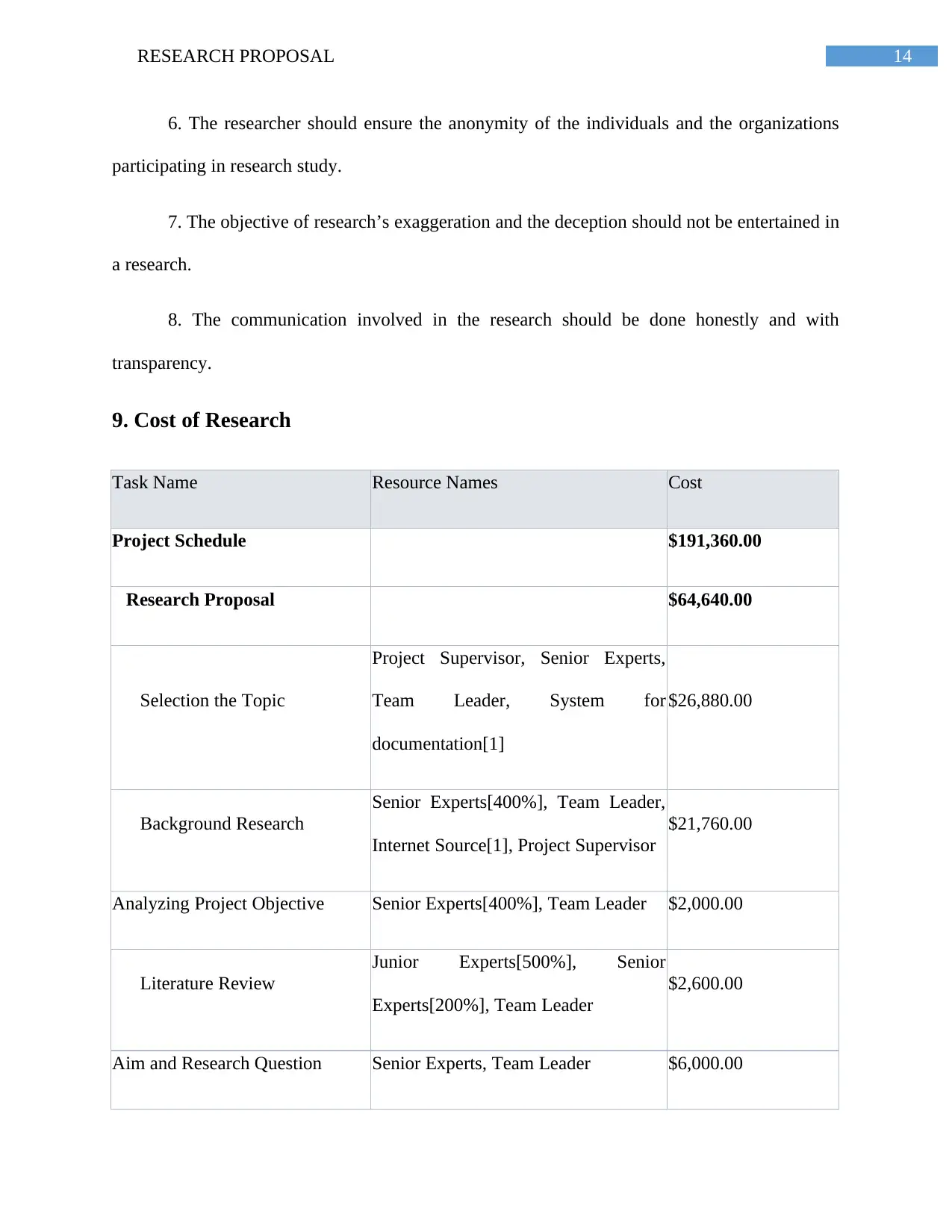
14RESEARCH PROPOSAL
6. The researcher should ensure the anonymity of the individuals and the organizations
participating in research study.
7. The objective of research’s exaggeration and the deception should not be entertained in
a research.
8. The communication involved in the research should be done honestly and with
transparency.
9. Cost of Research
Task Name Resource Names Cost
Project Schedule $191,360.00
Research Proposal $64,640.00
Selection the Topic
Project Supervisor, Senior Experts,
Team Leader, System for
documentation[1]
$26,880.00
Background Research
Senior Experts[400%], Team Leader,
Internet Source[1], Project Supervisor
$21,760.00
Analyzing Project Objective Senior Experts[400%], Team Leader $2,000.00
Literature Review
Junior Experts[500%], Senior
Experts[200%], Team Leader
$2,600.00
Aim and Research Question Senior Experts, Team Leader $6,000.00
6. The researcher should ensure the anonymity of the individuals and the organizations
participating in research study.
7. The objective of research’s exaggeration and the deception should not be entertained in
a research.
8. The communication involved in the research should be done honestly and with
transparency.
9. Cost of Research
Task Name Resource Names Cost
Project Schedule $191,360.00
Research Proposal $64,640.00
Selection the Topic
Project Supervisor, Senior Experts,
Team Leader, System for
documentation[1]
$26,880.00
Background Research
Senior Experts[400%], Team Leader,
Internet Source[1], Project Supervisor
$21,760.00
Analyzing Project Objective Senior Experts[400%], Team Leader $2,000.00
Literature Review
Junior Experts[500%], Senior
Experts[200%], Team Leader
$2,600.00
Aim and Research Question Senior Experts, Team Leader $6,000.00

15RESEARCH PROPOSAL
Research Methodology and
Research Design
Junior Experts, Senior Experts $2,800.00
Limitations of the Research Junior Experts $600.00
Preparing the Project
Schedule
Senior Experts, Team Leader $2,000.00
Submitting the Research
Proposal
Assistant Manager, Junior Experts,
Senior Experts, Team Leader
$0.00
Literature Review $21,000.00
Impact of Service quality and
the influence of service on
customer satisfaction
Junior Experts, Senior Experts $7,000.00
Different switching cost as
well as alternative evaluation that
effects the switching barrier of
telecommunication
Junior Experts, Senior Experts $7,000.00
Customer satisfaction as well
as switching barriers affecting the
customer loyalty in the
telecommunication industry
Junior Experts, Senior Experts $7,000.00
Data Collection Method $58,840.00
Research Methodology and
Research Design
Junior Experts, Senior Experts $2,800.00
Limitations of the Research Junior Experts $600.00
Preparing the Project
Schedule
Senior Experts, Team Leader $2,000.00
Submitting the Research
Proposal
Assistant Manager, Junior Experts,
Senior Experts, Team Leader
$0.00
Literature Review $21,000.00
Impact of Service quality and
the influence of service on
customer satisfaction
Junior Experts, Senior Experts $7,000.00
Different switching cost as
well as alternative evaluation that
effects the switching barrier of
telecommunication
Junior Experts, Senior Experts $7,000.00
Customer satisfaction as well
as switching barriers affecting the
customer loyalty in the
telecommunication industry
Junior Experts, Senior Experts $7,000.00
Data Collection Method $58,840.00
Secure Best Marks with AI Grader
Need help grading? Try our AI Grader for instant feedback on your assignments.
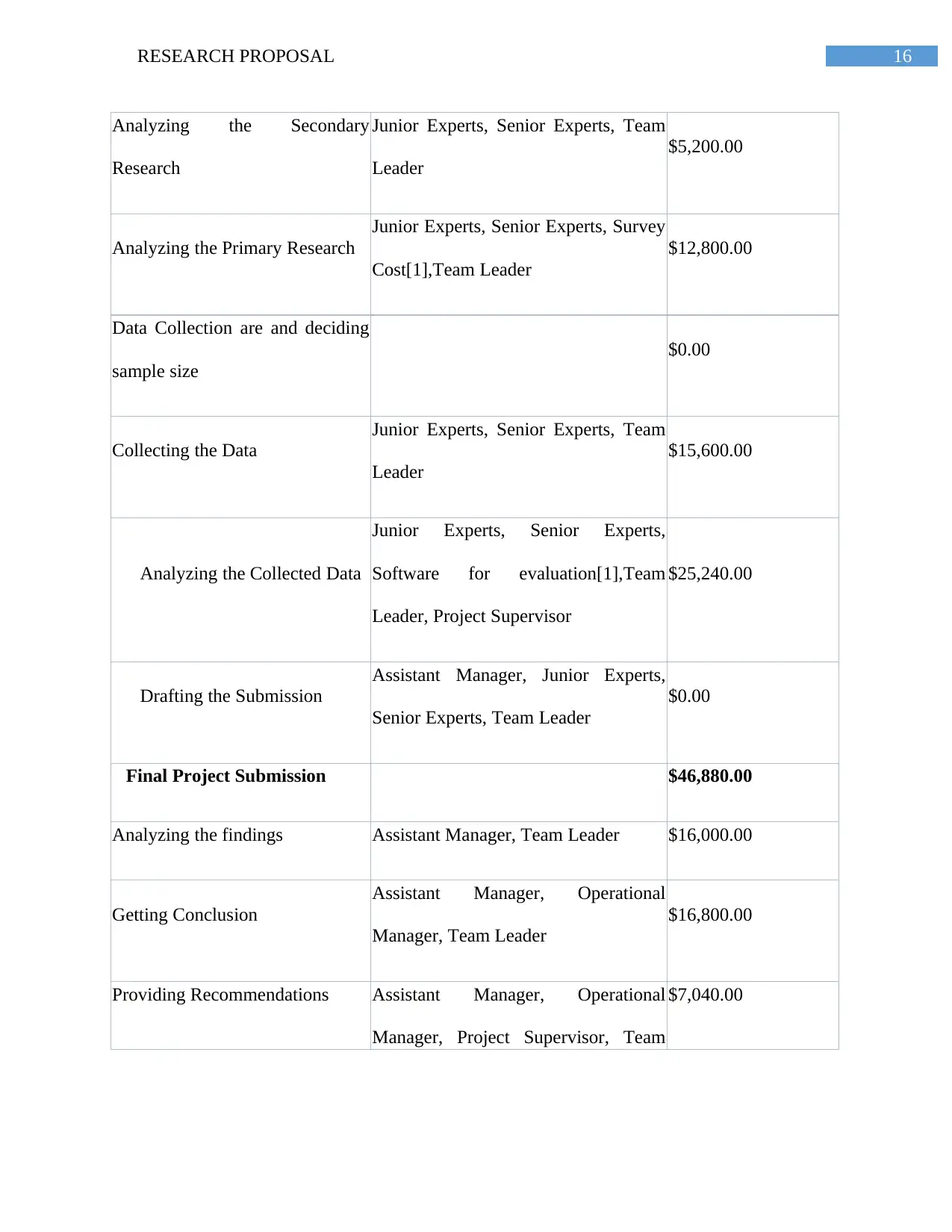
16RESEARCH PROPOSAL
Analyzing the Secondary
Research
Junior Experts, Senior Experts, Team
Leader
$5,200.00
Analyzing the Primary Research
Junior Experts, Senior Experts, Survey
Cost[1],Team Leader
$12,800.00
Data Collection are and deciding
sample size
$0.00
Collecting the Data
Junior Experts, Senior Experts, Team
Leader
$15,600.00
Analyzing the Collected Data
Junior Experts, Senior Experts,
Software for evaluation[1],Team
Leader, Project Supervisor
$25,240.00
Drafting the Submission
Assistant Manager, Junior Experts,
Senior Experts, Team Leader
$0.00
Final Project Submission $46,880.00
Analyzing the findings Assistant Manager, Team Leader $16,000.00
Getting Conclusion
Assistant Manager, Operational
Manager, Team Leader
$16,800.00
Providing Recommendations Assistant Manager, Operational
Manager, Project Supervisor, Team
$7,040.00
Analyzing the Secondary
Research
Junior Experts, Senior Experts, Team
Leader
$5,200.00
Analyzing the Primary Research
Junior Experts, Senior Experts, Survey
Cost[1],Team Leader
$12,800.00
Data Collection are and deciding
sample size
$0.00
Collecting the Data
Junior Experts, Senior Experts, Team
Leader
$15,600.00
Analyzing the Collected Data
Junior Experts, Senior Experts,
Software for evaluation[1],Team
Leader, Project Supervisor
$25,240.00
Drafting the Submission
Assistant Manager, Junior Experts,
Senior Experts, Team Leader
$0.00
Final Project Submission $46,880.00
Analyzing the findings Assistant Manager, Team Leader $16,000.00
Getting Conclusion
Assistant Manager, Operational
Manager, Team Leader
$16,800.00
Providing Recommendations Assistant Manager, Operational
Manager, Project Supervisor, Team
$7,040.00

17RESEARCH PROPOSAL
Leader
Project Report Final
Submission
Assistant Manager, Operational
Manager, Project Supervisor, Team
Leader
$7,040.00
10. Timeline
Activities Mar-19 Apr-19 May-19
Week
1
Week
2
Week
3
Week
4
Week
5
Week
1
Week
2
Week
3
Week
4
Week
1
Week
2
Week
3
Week
4
Selection the
Topic
Background
Research
Analyzing
Project
Objective
Literature
Review
Aim and
Research
Question
Research
Methodology
and Research
Design
Limitations of
the Research
Preparing the
Project
Schedule
Submitting the
Research
Proposal
Impact of
Service quality
and the
influence of
service on
Leader
Project Report Final
Submission
Assistant Manager, Operational
Manager, Project Supervisor, Team
Leader
$7,040.00
10. Timeline
Activities Mar-19 Apr-19 May-19
Week
1
Week
2
Week
3
Week
4
Week
5
Week
1
Week
2
Week
3
Week
4
Week
1
Week
2
Week
3
Week
4
Selection the
Topic
Background
Research
Analyzing
Project
Objective
Literature
Review
Aim and
Research
Question
Research
Methodology
and Research
Design
Limitations of
the Research
Preparing the
Project
Schedule
Submitting the
Research
Proposal
Impact of
Service quality
and the
influence of
service on
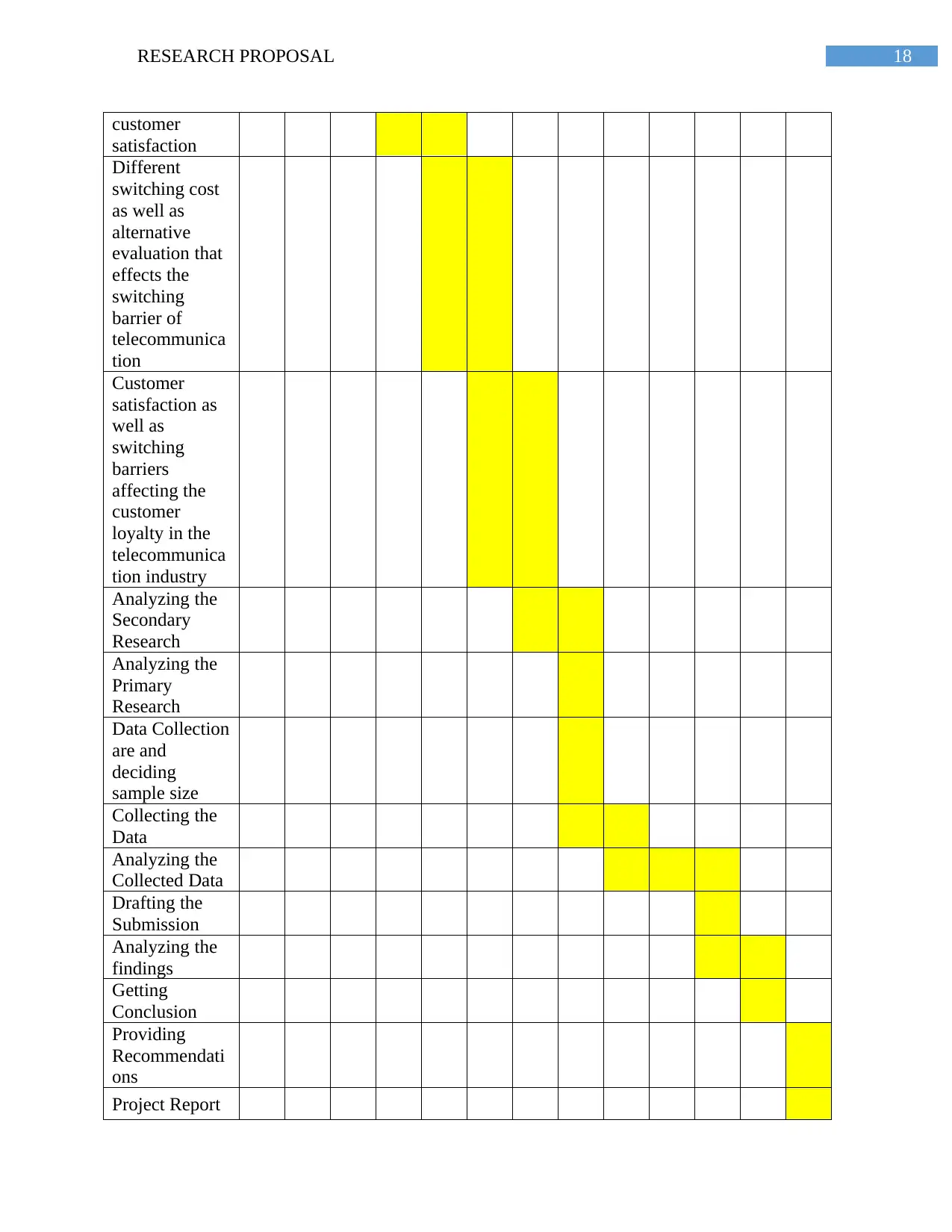
18RESEARCH PROPOSAL
customer
satisfaction
Different
switching cost
as well as
alternative
evaluation that
effects the
switching
barrier of
telecommunica
tion
Customer
satisfaction as
well as
switching
barriers
affecting the
customer
loyalty in the
telecommunica
tion industry
Analyzing the
Secondary
Research
Analyzing the
Primary
Research
Data Collection
are and
deciding
sample size
Collecting the
Data
Analyzing the
Collected Data
Drafting the
Submission
Analyzing the
findings
Getting
Conclusion
Providing
Recommendati
ons
Project Report
customer
satisfaction
Different
switching cost
as well as
alternative
evaluation that
effects the
switching
barrier of
telecommunica
tion
Customer
satisfaction as
well as
switching
barriers
affecting the
customer
loyalty in the
telecommunica
tion industry
Analyzing the
Secondary
Research
Analyzing the
Primary
Research
Data Collection
are and
deciding
sample size
Collecting the
Data
Analyzing the
Collected Data
Drafting the
Submission
Analyzing the
findings
Getting
Conclusion
Providing
Recommendati
ons
Project Report
Paraphrase This Document
Need a fresh take? Get an instant paraphrase of this document with our AI Paraphraser

19RESEARCH PROPOSAL
Final
Submission
Final
Submission
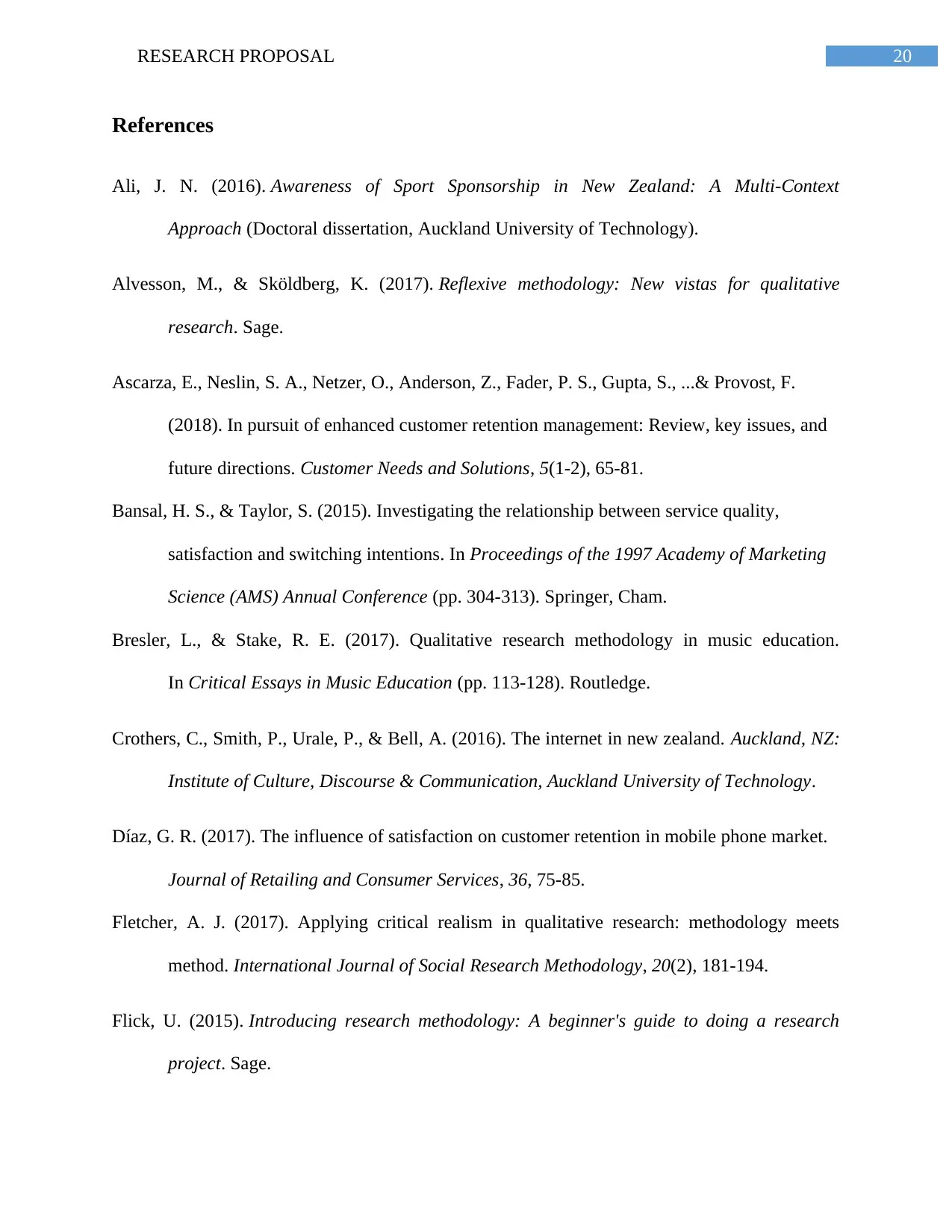
20RESEARCH PROPOSAL
References
Ali, J. N. (2016). Awareness of Sport Sponsorship in New Zealand: A Multi-Context
Approach (Doctoral dissertation, Auckland University of Technology).
Alvesson, M., & Sköldberg, K. (2017). Reflexive methodology: New vistas for qualitative
research. Sage.
Ascarza, E., Neslin, S. A., Netzer, O., Anderson, Z., Fader, P. S., Gupta, S., ...& Provost, F.
(2018). In pursuit of enhanced customer retention management: Review, key issues, and
future directions. Customer Needs and Solutions, 5(1-2), 65-81.
Bansal, H. S., & Taylor, S. (2015). Investigating the relationship between service quality,
satisfaction and switching intentions. In Proceedings of the 1997 Academy of Marketing
Science (AMS) Annual Conference (pp. 304-313). Springer, Cham.
Bresler, L., & Stake, R. E. (2017). Qualitative research methodology in music education.
In Critical Essays in Music Education (pp. 113-128). Routledge.
Crothers, C., Smith, P., Urale, P., & Bell, A. (2016). The internet in new zealand. Auckland, NZ:
Institute of Culture, Discourse & Communication, Auckland University of Technology.
Díaz, G. R. (2017). The influence of satisfaction on customer retention in mobile phone market.
Journal of Retailing and Consumer Services, 36, 75-85.
Fletcher, A. J. (2017). Applying critical realism in qualitative research: methodology meets
method. International Journal of Social Research Methodology, 20(2), 181-194.
Flick, U. (2015). Introducing research methodology: A beginner's guide to doing a research
project. Sage.
References
Ali, J. N. (2016). Awareness of Sport Sponsorship in New Zealand: A Multi-Context
Approach (Doctoral dissertation, Auckland University of Technology).
Alvesson, M., & Sköldberg, K. (2017). Reflexive methodology: New vistas for qualitative
research. Sage.
Ascarza, E., Neslin, S. A., Netzer, O., Anderson, Z., Fader, P. S., Gupta, S., ...& Provost, F.
(2018). In pursuit of enhanced customer retention management: Review, key issues, and
future directions. Customer Needs and Solutions, 5(1-2), 65-81.
Bansal, H. S., & Taylor, S. (2015). Investigating the relationship between service quality,
satisfaction and switching intentions. In Proceedings of the 1997 Academy of Marketing
Science (AMS) Annual Conference (pp. 304-313). Springer, Cham.
Bresler, L., & Stake, R. E. (2017). Qualitative research methodology in music education.
In Critical Essays in Music Education (pp. 113-128). Routledge.
Crothers, C., Smith, P., Urale, P., & Bell, A. (2016). The internet in new zealand. Auckland, NZ:
Institute of Culture, Discourse & Communication, Auckland University of Technology.
Díaz, G. R. (2017). The influence of satisfaction on customer retention in mobile phone market.
Journal of Retailing and Consumer Services, 36, 75-85.
Fletcher, A. J. (2017). Applying critical realism in qualitative research: methodology meets
method. International Journal of Social Research Methodology, 20(2), 181-194.
Flick, U. (2015). Introducing research methodology: A beginner's guide to doing a research
project. Sage.
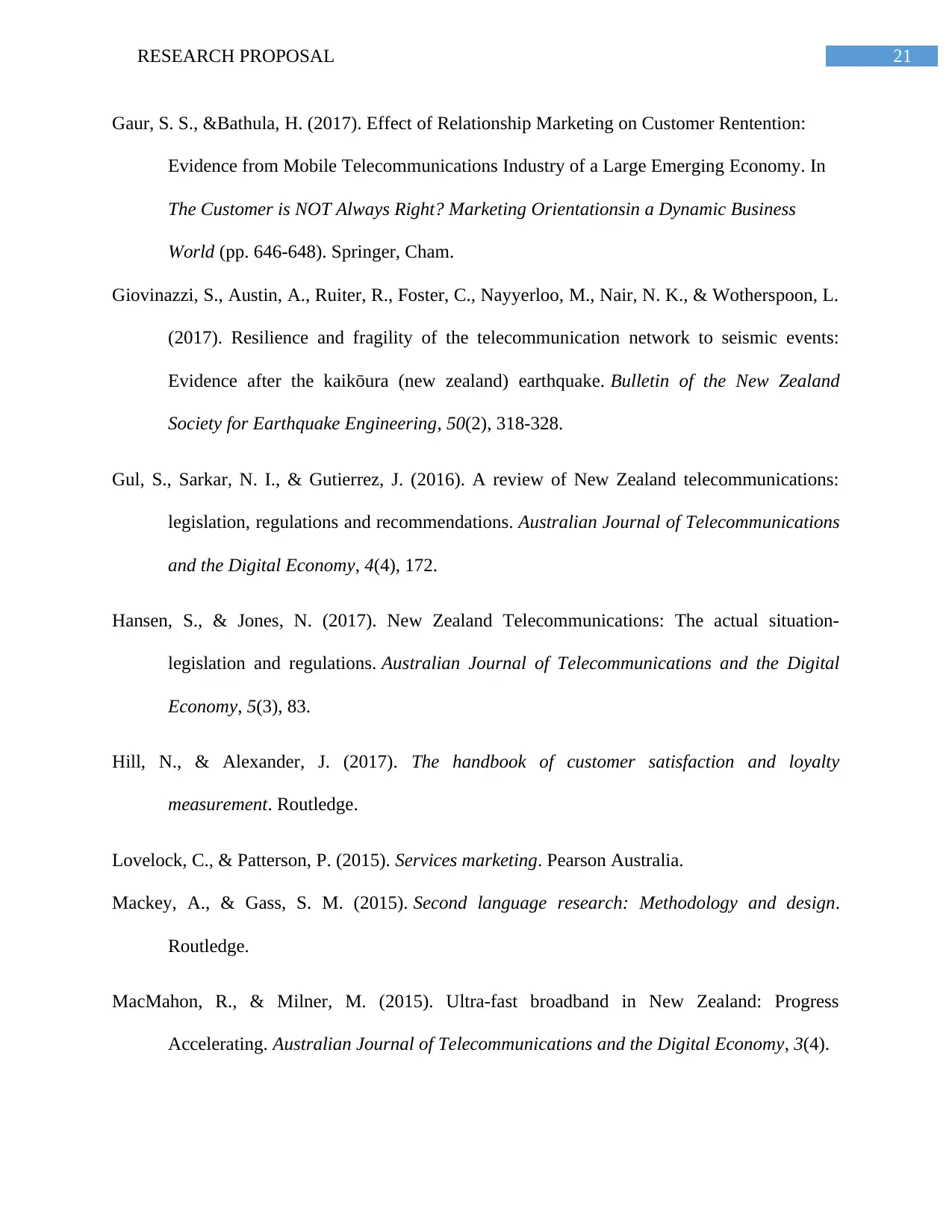
21RESEARCH PROPOSAL
Gaur, S. S., &Bathula, H. (2017). Effect of Relationship Marketing on Customer Rentention:
Evidence from Mobile Telecommunications Industry of a Large Emerging Economy. In
The Customer is NOT Always Right? Marketing Orientationsin a Dynamic Business
World (pp. 646-648). Springer, Cham.
Giovinazzi, S., Austin, A., Ruiter, R., Foster, C., Nayyerloo, M., Nair, N. K., & Wotherspoon, L.
(2017). Resilience and fragility of the telecommunication network to seismic events:
Evidence after the kaikōura (new zealand) earthquake. Bulletin of the New Zealand
Society for Earthquake Engineering, 50(2), 318-328.
Gul, S., Sarkar, N. I., & Gutierrez, J. (2016). A review of New Zealand telecommunications:
legislation, regulations and recommendations. Australian Journal of Telecommunications
and the Digital Economy, 4(4), 172.
Hansen, S., & Jones, N. (2017). New Zealand Telecommunications: The actual situation-
legislation and regulations. Australian Journal of Telecommunications and the Digital
Economy, 5(3), 83.
Hill, N., & Alexander, J. (2017). The handbook of customer satisfaction and loyalty
measurement. Routledge.
Lovelock, C., & Patterson, P. (2015). Services marketing. Pearson Australia.
Mackey, A., & Gass, S. M. (2015). Second language research: Methodology and design.
Routledge.
MacMahon, R., & Milner, M. (2015). Ultra-fast broadband in New Zealand: Progress
Accelerating. Australian Journal of Telecommunications and the Digital Economy, 3(4).
Gaur, S. S., &Bathula, H. (2017). Effect of Relationship Marketing on Customer Rentention:
Evidence from Mobile Telecommunications Industry of a Large Emerging Economy. In
The Customer is NOT Always Right? Marketing Orientationsin a Dynamic Business
World (pp. 646-648). Springer, Cham.
Giovinazzi, S., Austin, A., Ruiter, R., Foster, C., Nayyerloo, M., Nair, N. K., & Wotherspoon, L.
(2017). Resilience and fragility of the telecommunication network to seismic events:
Evidence after the kaikōura (new zealand) earthquake. Bulletin of the New Zealand
Society for Earthquake Engineering, 50(2), 318-328.
Gul, S., Sarkar, N. I., & Gutierrez, J. (2016). A review of New Zealand telecommunications:
legislation, regulations and recommendations. Australian Journal of Telecommunications
and the Digital Economy, 4(4), 172.
Hansen, S., & Jones, N. (2017). New Zealand Telecommunications: The actual situation-
legislation and regulations. Australian Journal of Telecommunications and the Digital
Economy, 5(3), 83.
Hill, N., & Alexander, J. (2017). The handbook of customer satisfaction and loyalty
measurement. Routledge.
Lovelock, C., & Patterson, P. (2015). Services marketing. Pearson Australia.
Mackey, A., & Gass, S. M. (2015). Second language research: Methodology and design.
Routledge.
MacMahon, R., & Milner, M. (2015). Ultra-fast broadband in New Zealand: Progress
Accelerating. Australian Journal of Telecommunications and the Digital Economy, 3(4).
Secure Best Marks with AI Grader
Need help grading? Try our AI Grader for instant feedback on your assignments.
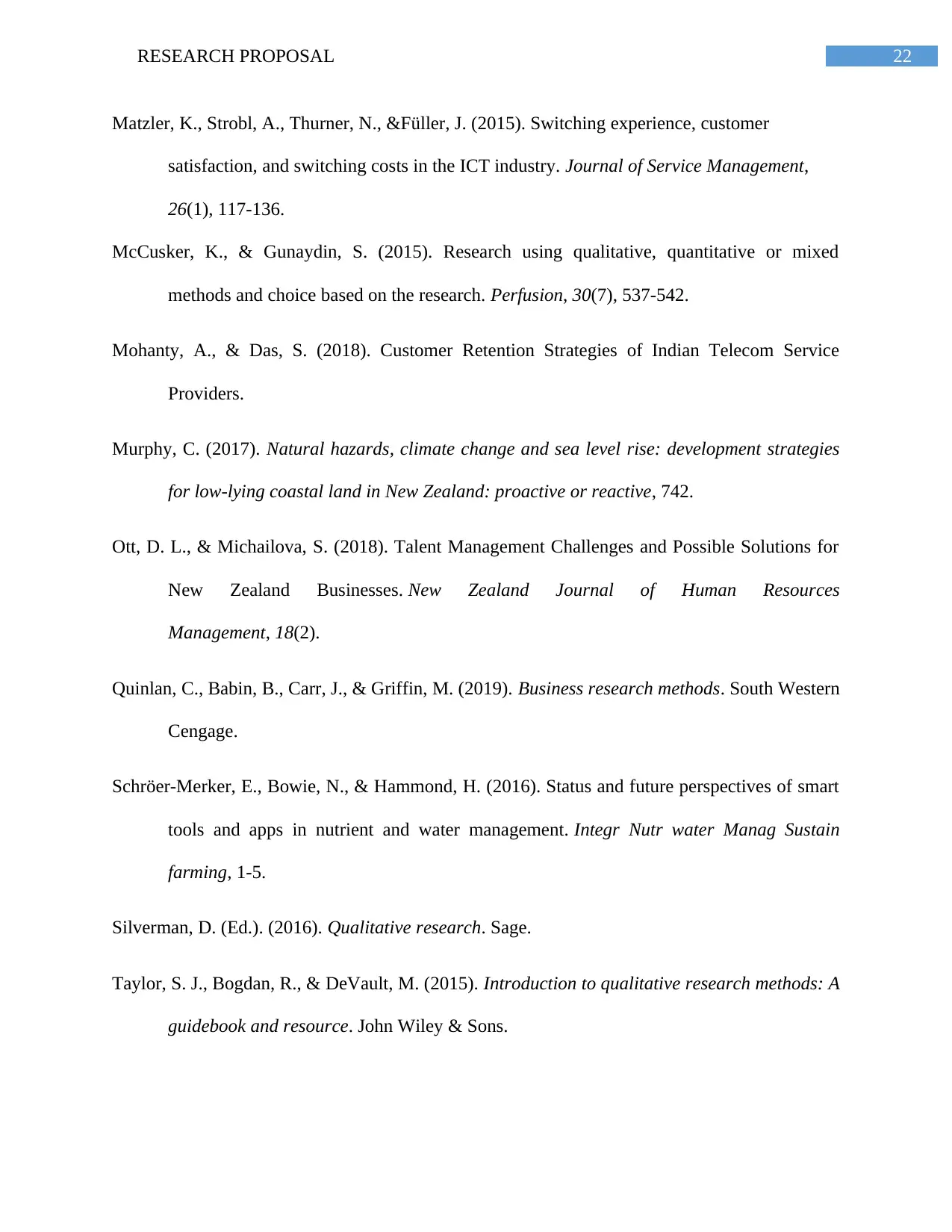
22RESEARCH PROPOSAL
Matzler, K., Strobl, A., Thurner, N., &Füller, J. (2015). Switching experience, customer
satisfaction, and switching costs in the ICT industry. Journal of Service Management,
26(1), 117-136.
McCusker, K., & Gunaydin, S. (2015). Research using qualitative, quantitative or mixed
methods and choice based on the research. Perfusion, 30(7), 537-542.
Mohanty, A., & Das, S. (2018). Customer Retention Strategies of Indian Telecom Service
Providers.
Murphy, C. (2017). Natural hazards, climate change and sea level rise: development strategies
for low-lying coastal land in New Zealand: proactive or reactive, 742.
Ott, D. L., & Michailova, S. (2018). Talent Management Challenges and Possible Solutions for
New Zealand Businesses. New Zealand Journal of Human Resources
Management, 18(2).
Quinlan, C., Babin, B., Carr, J., & Griffin, M. (2019). Business research methods. South Western
Cengage.
Schröer-Merker, E., Bowie, N., & Hammond, H. (2016). Status and future perspectives of smart
tools and apps in nutrient and water management. Integr Nutr water Manag Sustain
farming, 1-5.
Silverman, D. (Ed.). (2016). Qualitative research. Sage.
Taylor, S. J., Bogdan, R., & DeVault, M. (2015). Introduction to qualitative research methods: A
guidebook and resource. John Wiley & Sons.
Matzler, K., Strobl, A., Thurner, N., &Füller, J. (2015). Switching experience, customer
satisfaction, and switching costs in the ICT industry. Journal of Service Management,
26(1), 117-136.
McCusker, K., & Gunaydin, S. (2015). Research using qualitative, quantitative or mixed
methods and choice based on the research. Perfusion, 30(7), 537-542.
Mohanty, A., & Das, S. (2018). Customer Retention Strategies of Indian Telecom Service
Providers.
Murphy, C. (2017). Natural hazards, climate change and sea level rise: development strategies
for low-lying coastal land in New Zealand: proactive or reactive, 742.
Ott, D. L., & Michailova, S. (2018). Talent Management Challenges and Possible Solutions for
New Zealand Businesses. New Zealand Journal of Human Resources
Management, 18(2).
Quinlan, C., Babin, B., Carr, J., & Griffin, M. (2019). Business research methods. South Western
Cengage.
Schröer-Merker, E., Bowie, N., & Hammond, H. (2016). Status and future perspectives of smart
tools and apps in nutrient and water management. Integr Nutr water Manag Sustain
farming, 1-5.
Silverman, D. (Ed.). (2016). Qualitative research. Sage.
Taylor, S. J., Bogdan, R., & DeVault, M. (2015). Introduction to qualitative research methods: A
guidebook and resource. John Wiley & Sons.

23RESEARCH PROPOSAL
Thaichon, P., & Quach, T. N. (2015). The relationship between service quality, satisfaction,
trust, value, commitment and loyalty of Internet service providers' customers. Journal of
Global Scholars of Marketing Science, 25(4), 295-313.
Walliman, N. (2017). Research methods: The basics. Routledge.
Thaichon, P., & Quach, T. N. (2015). The relationship between service quality, satisfaction,
trust, value, commitment and loyalty of Internet service providers' customers. Journal of
Global Scholars of Marketing Science, 25(4), 295-313.
Walliman, N. (2017). Research methods: The basics. Routledge.
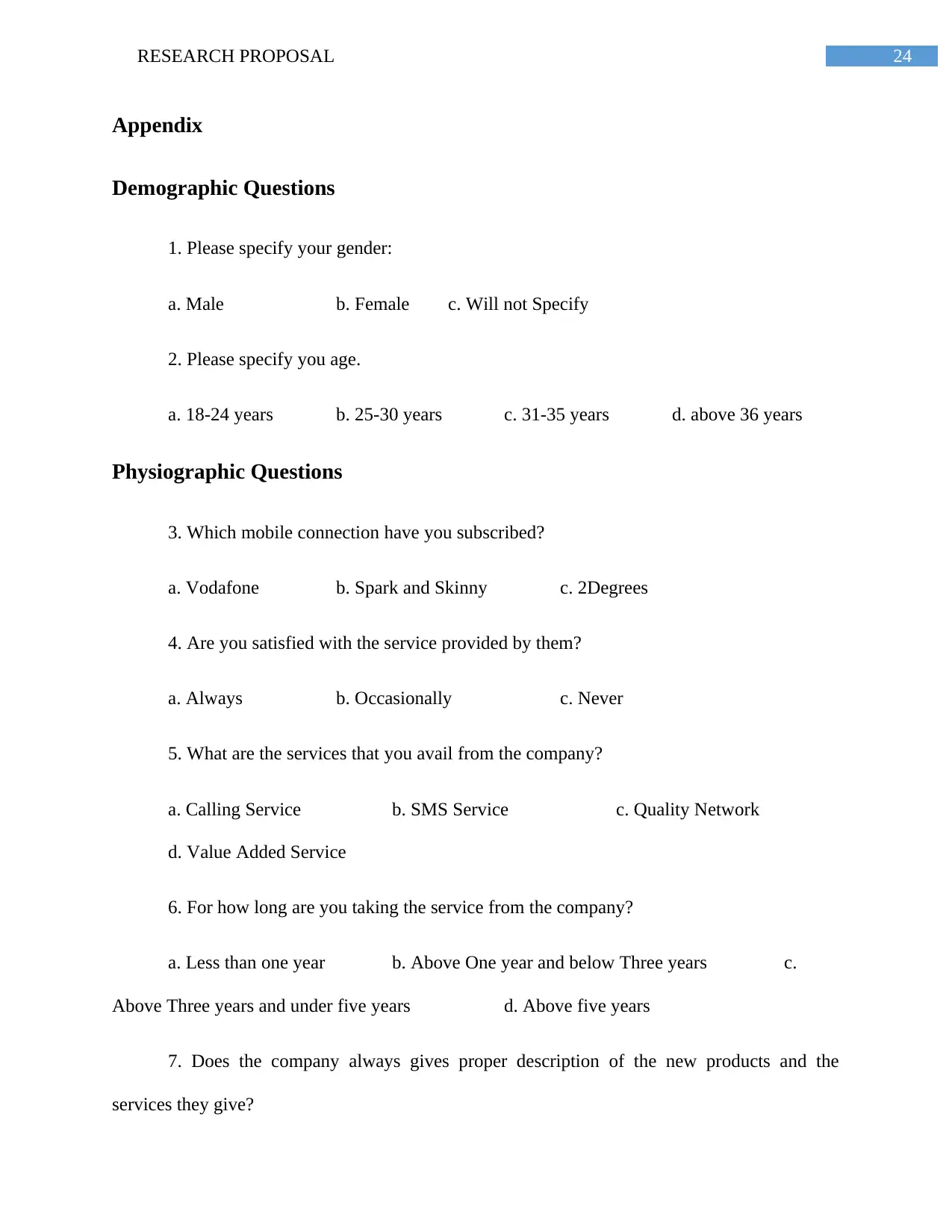
24RESEARCH PROPOSAL
Appendix
Demographic Questions
1. Please specify your gender:
a. Male b. Female c. Will not Specify
2. Please specify you age.
a. 18-24 years b. 25-30 years c. 31-35 years d. above 36 years
Physiographic Questions
3. Which mobile connection have you subscribed?
a. Vodafone b. Spark and Skinny c. 2Degrees
4. Are you satisfied with the service provided by them?
a. Always b. Occasionally c. Never
5. What are the services that you avail from the company?
a. Calling Service b. SMS Service c. Quality Network
d. Value Added Service
6. For how long are you taking the service from the company?
a. Less than one year b. Above One year and below Three years c.
Above Three years and under five years d. Above five years
7. Does the company always gives proper description of the new products and the
services they give?
Appendix
Demographic Questions
1. Please specify your gender:
a. Male b. Female c. Will not Specify
2. Please specify you age.
a. 18-24 years b. 25-30 years c. 31-35 years d. above 36 years
Physiographic Questions
3. Which mobile connection have you subscribed?
a. Vodafone b. Spark and Skinny c. 2Degrees
4. Are you satisfied with the service provided by them?
a. Always b. Occasionally c. Never
5. What are the services that you avail from the company?
a. Calling Service b. SMS Service c. Quality Network
d. Value Added Service
6. For how long are you taking the service from the company?
a. Less than one year b. Above One year and below Three years c.
Above Three years and under five years d. Above five years
7. Does the company always gives proper description of the new products and the
services they give?
Paraphrase This Document
Need a fresh take? Get an instant paraphrase of this document with our AI Paraphraser
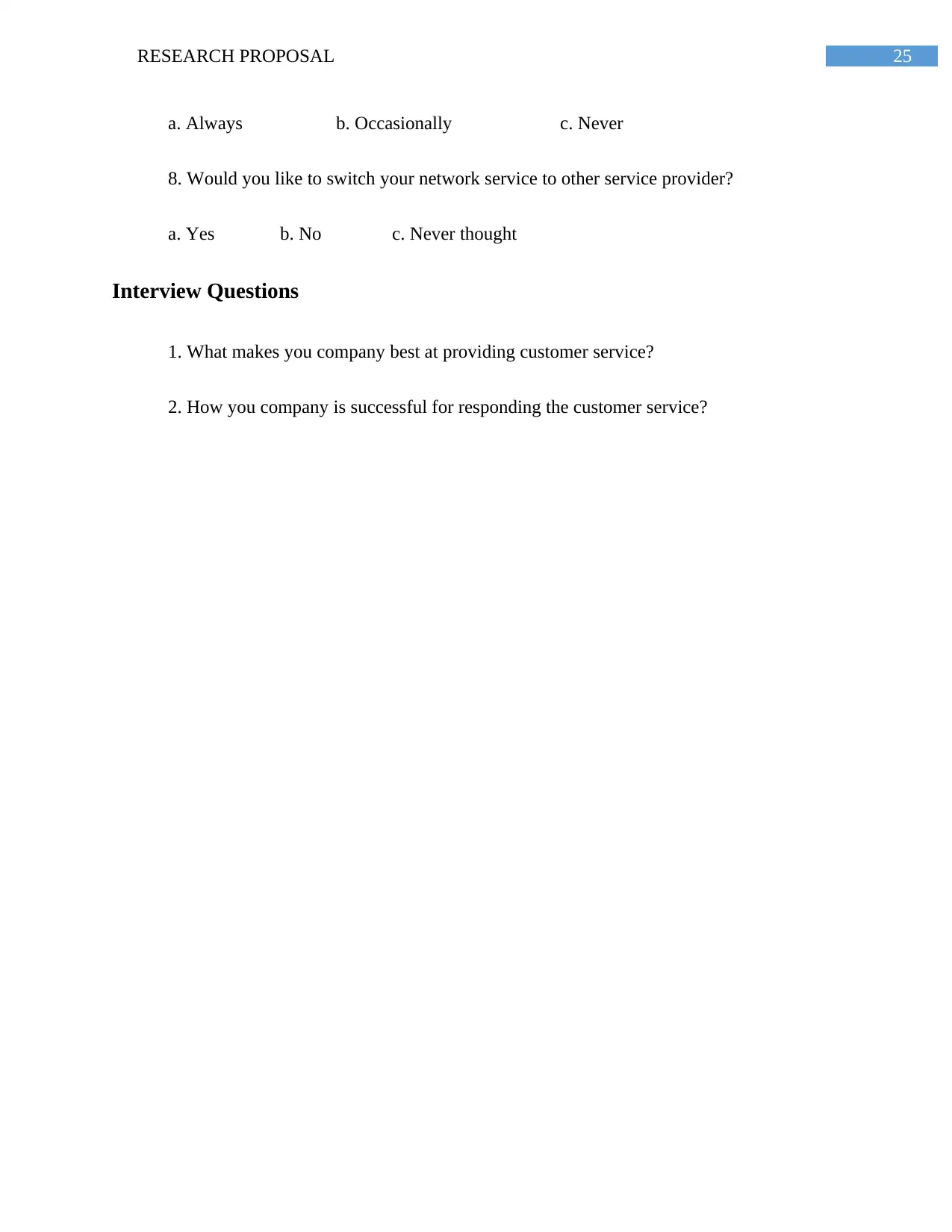
25RESEARCH PROPOSAL
a. Always b. Occasionally c. Never
8. Would you like to switch your network service to other service provider?
a. Yes b. No c. Never thought
Interview Questions
1. What makes you company best at providing customer service?
2. How you company is successful for responding the customer service?
a. Always b. Occasionally c. Never
8. Would you like to switch your network service to other service provider?
a. Yes b. No c. Never thought
Interview Questions
1. What makes you company best at providing customer service?
2. How you company is successful for responding the customer service?
1 out of 26
Related Documents
Your All-in-One AI-Powered Toolkit for Academic Success.
+13062052269
info@desklib.com
Available 24*7 on WhatsApp / Email
![[object Object]](/_next/static/media/star-bottom.7253800d.svg)
Unlock your academic potential
© 2024 | Zucol Services PVT LTD | All rights reserved.




